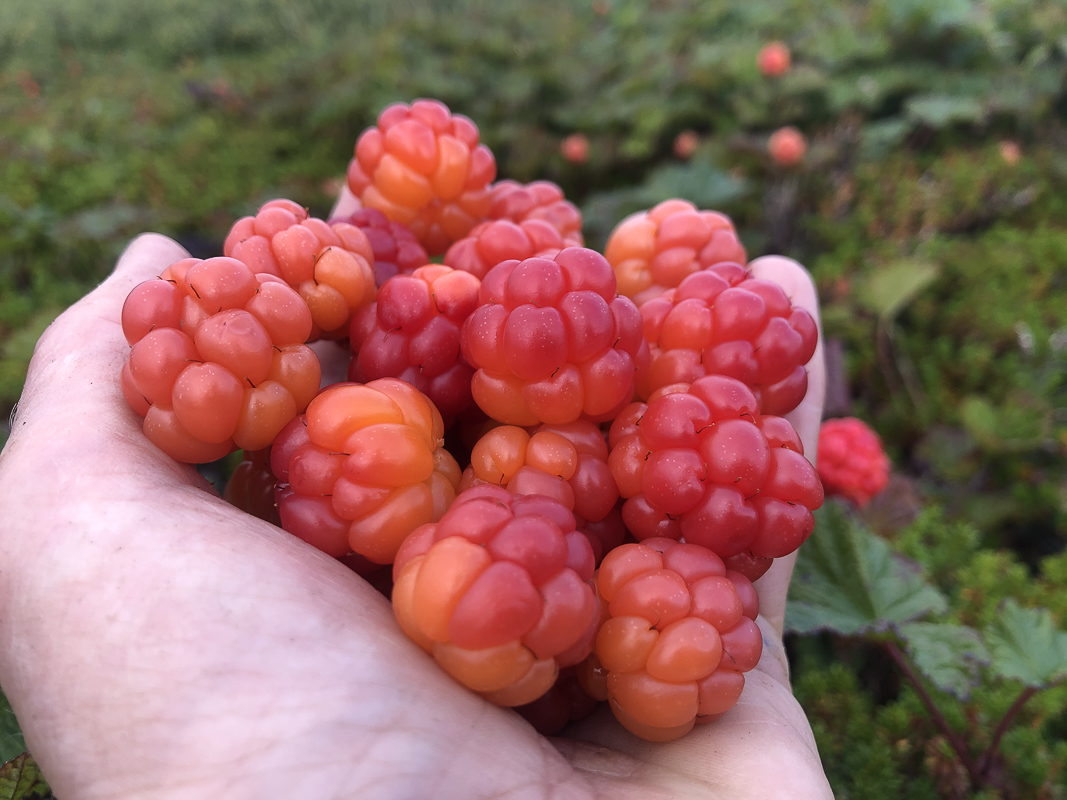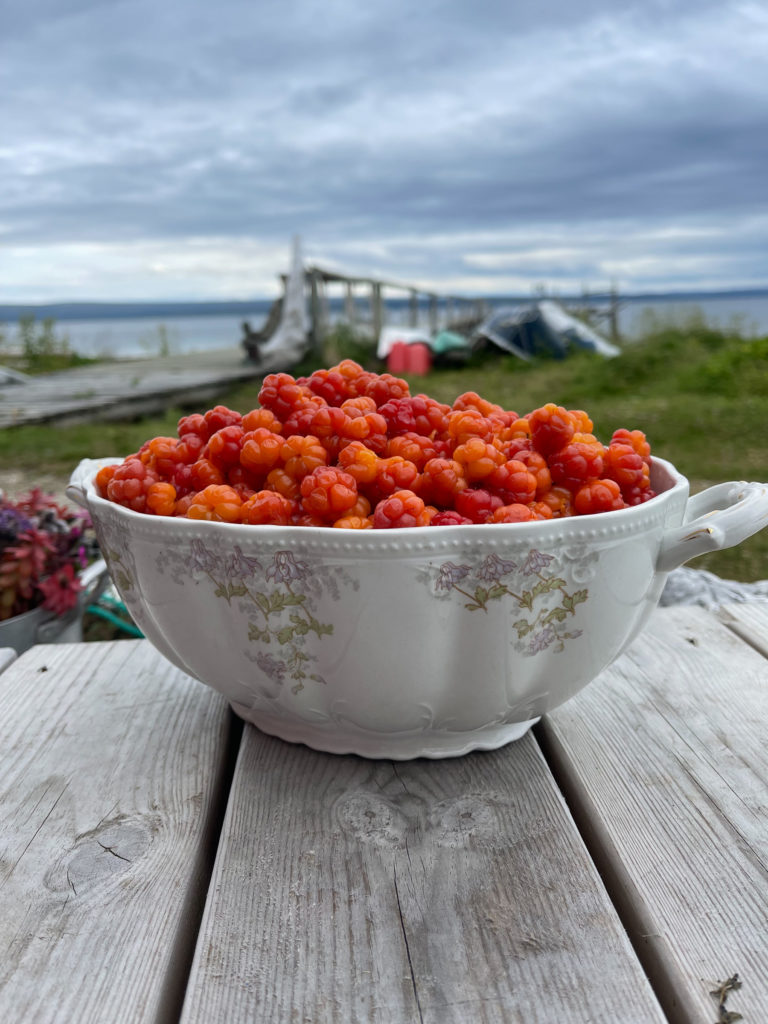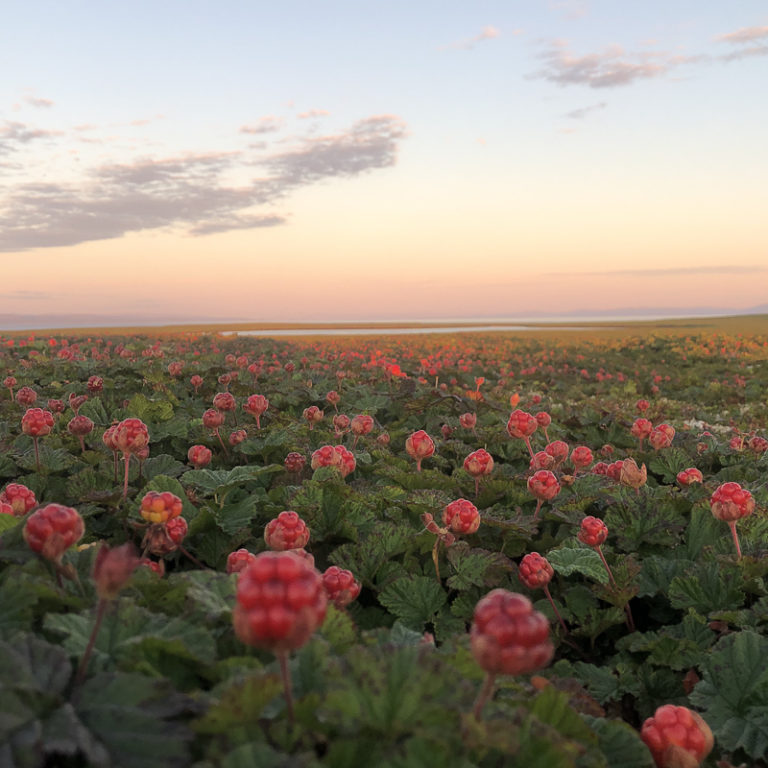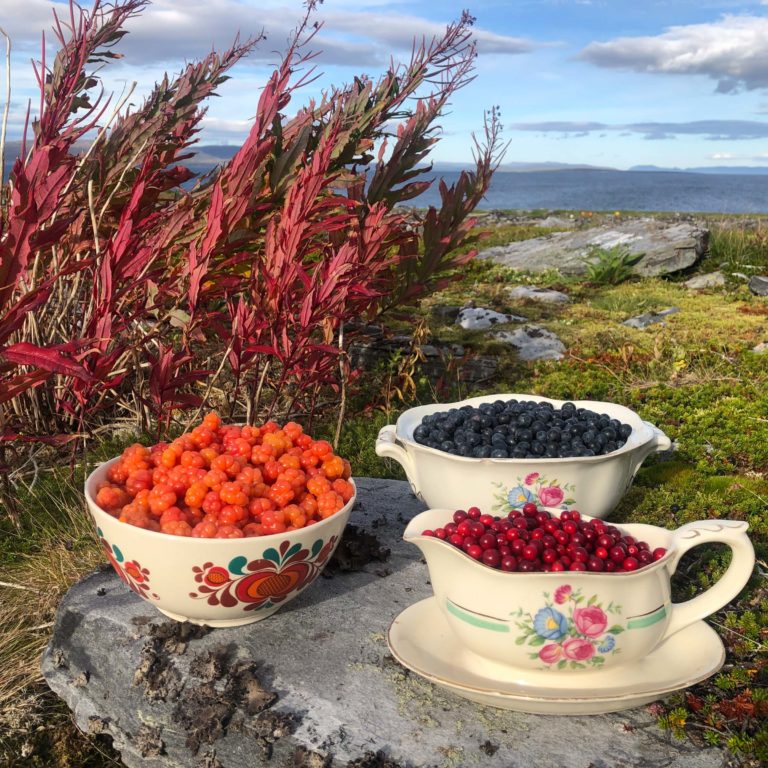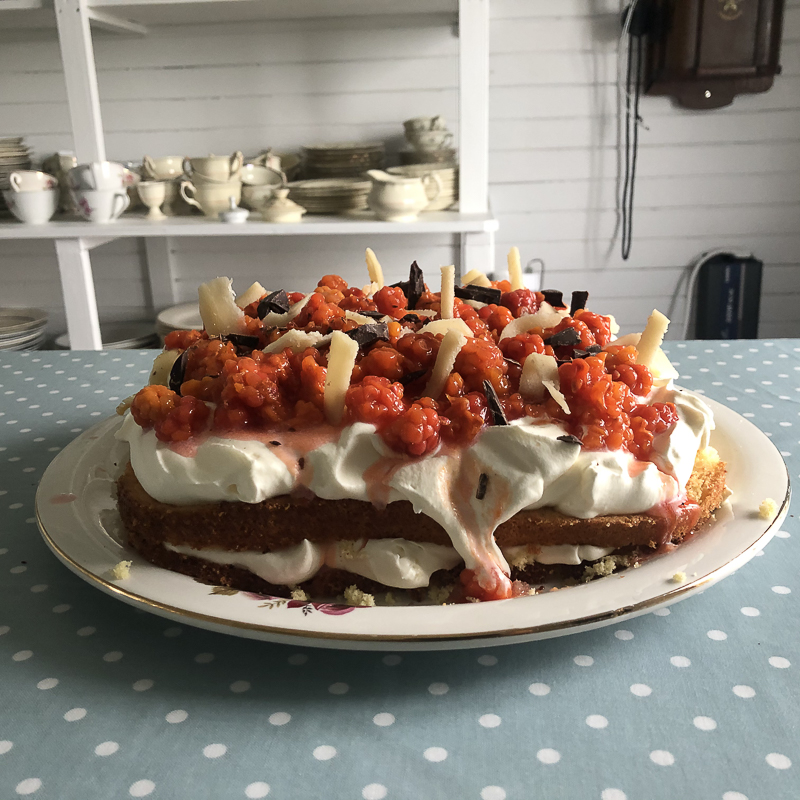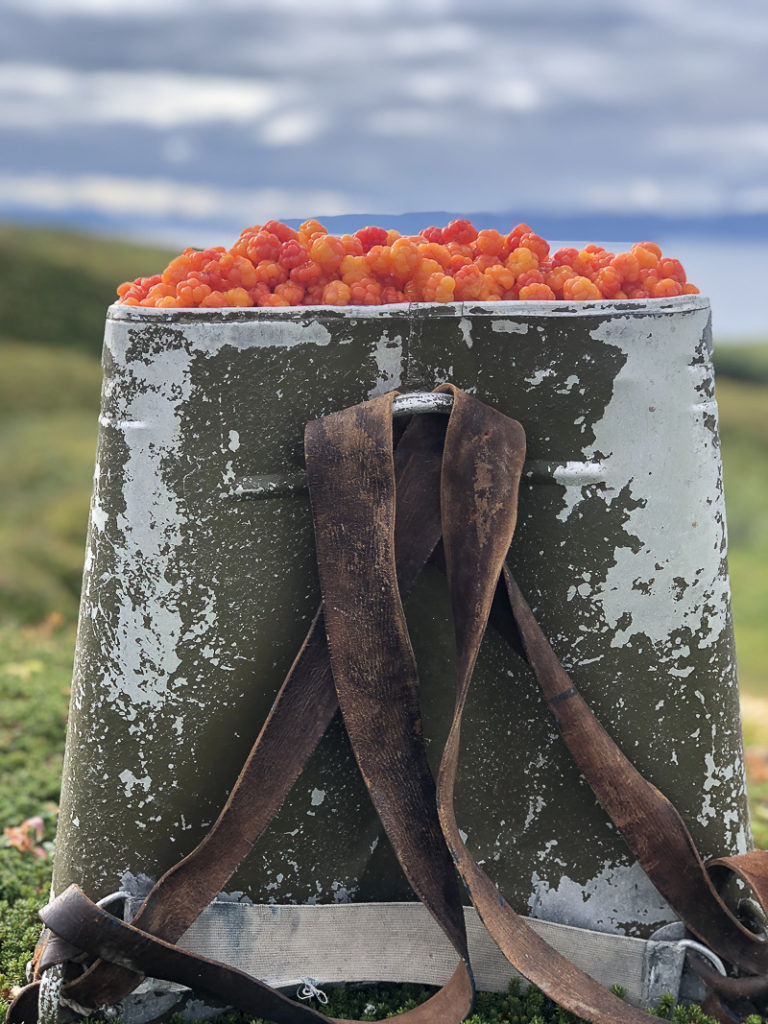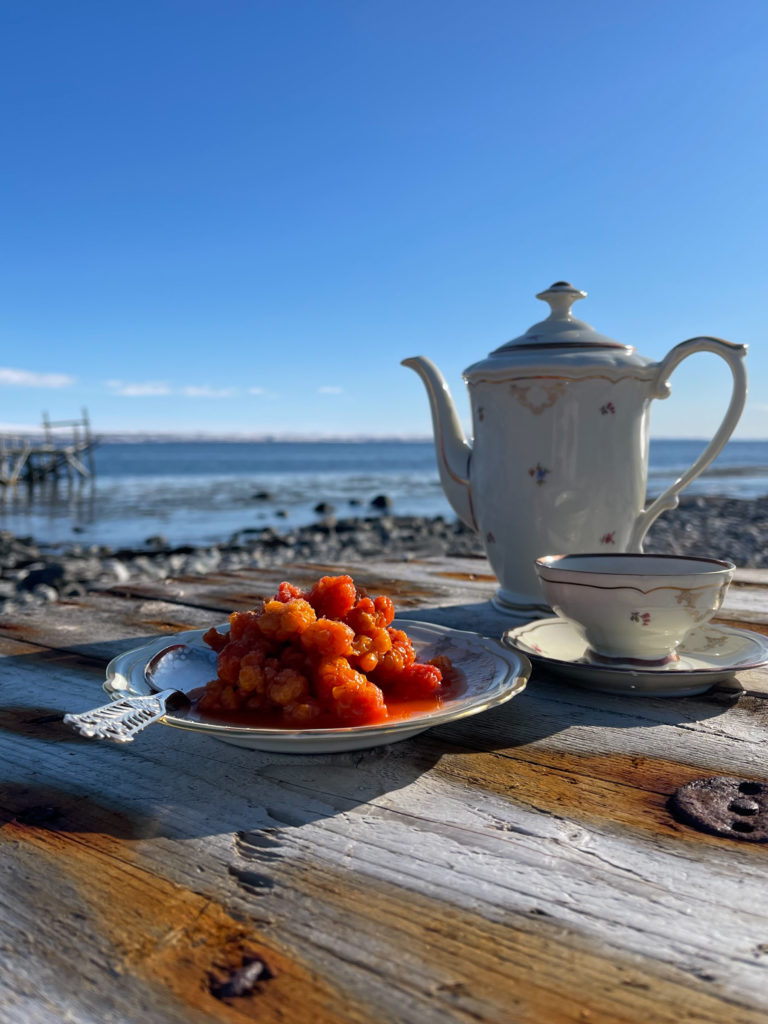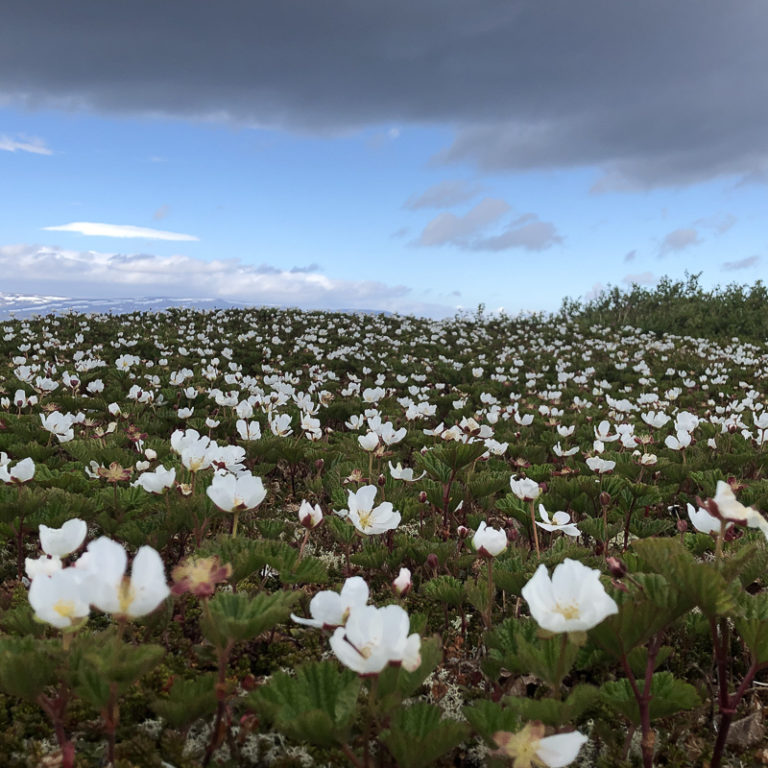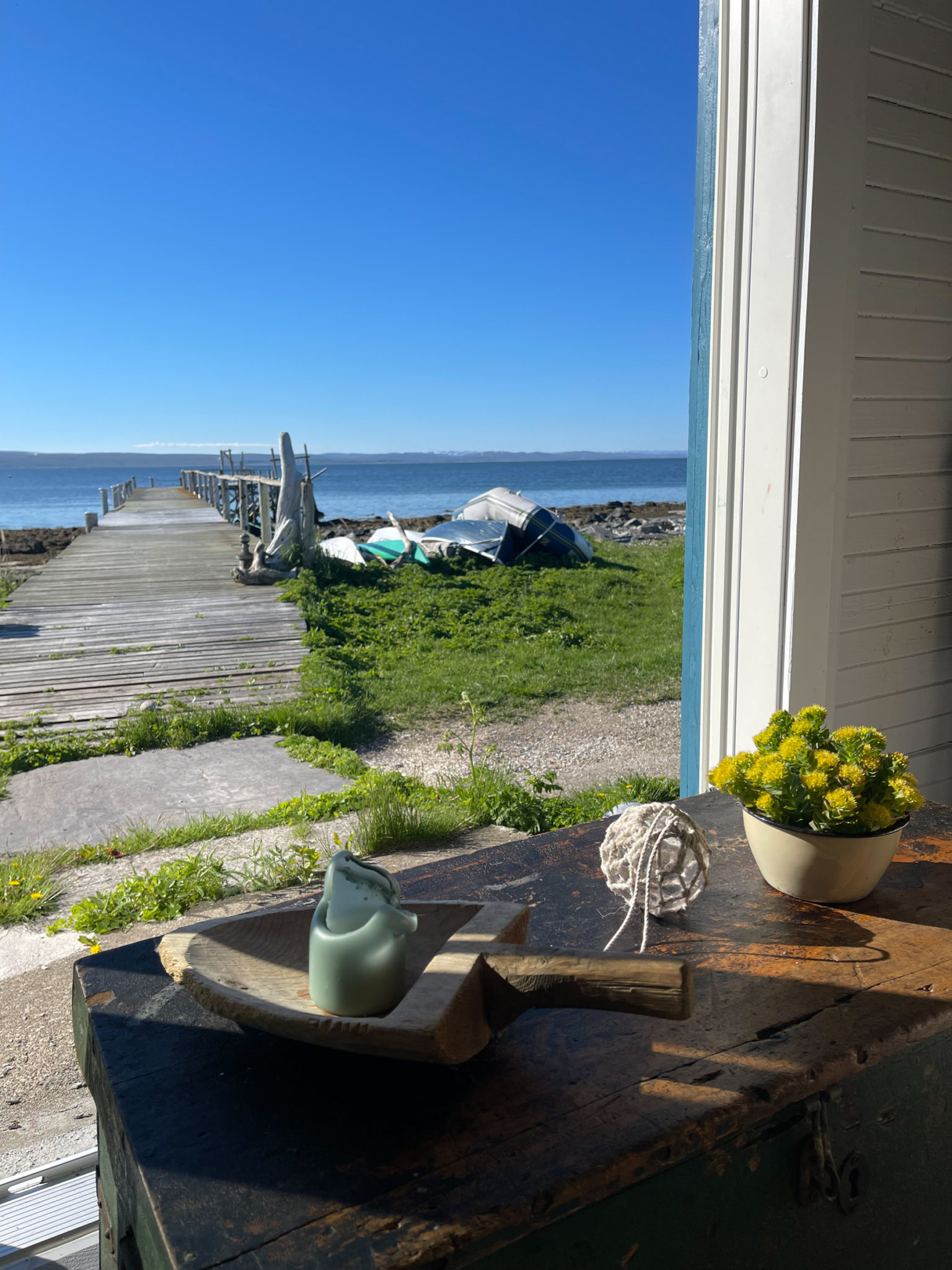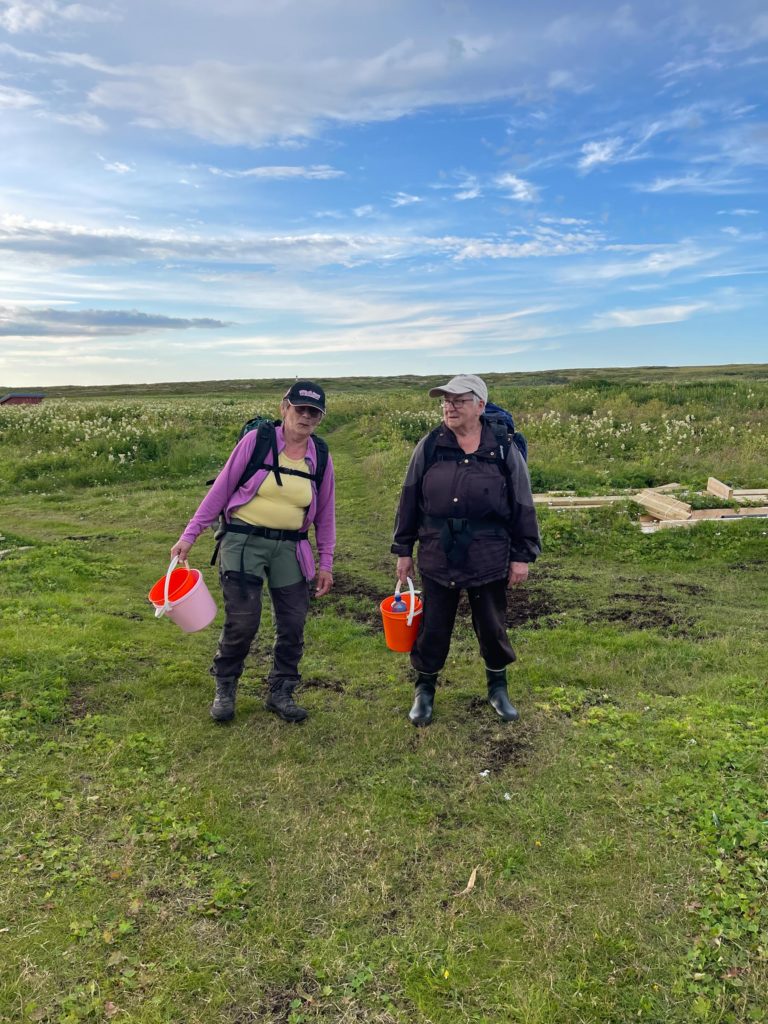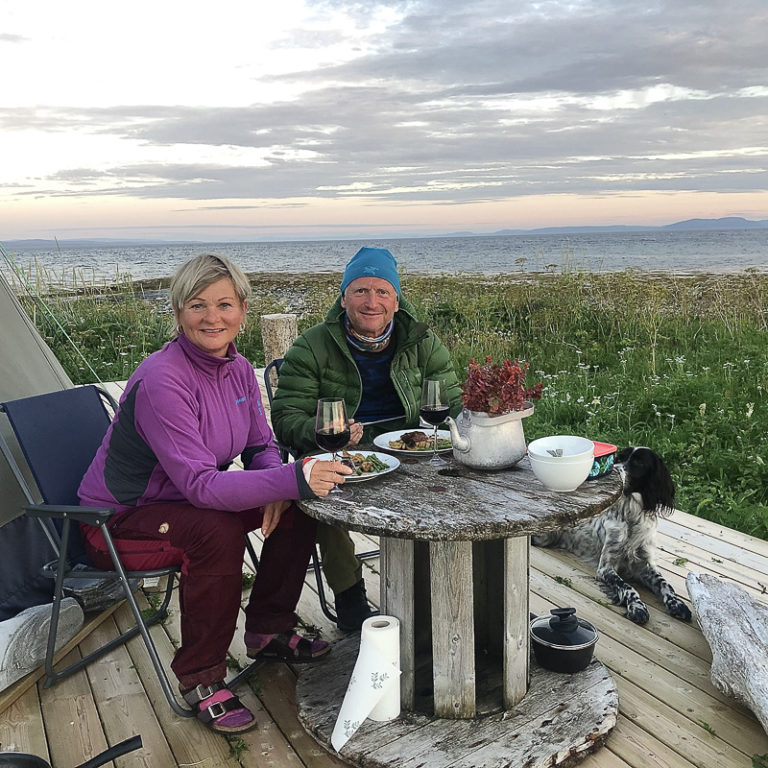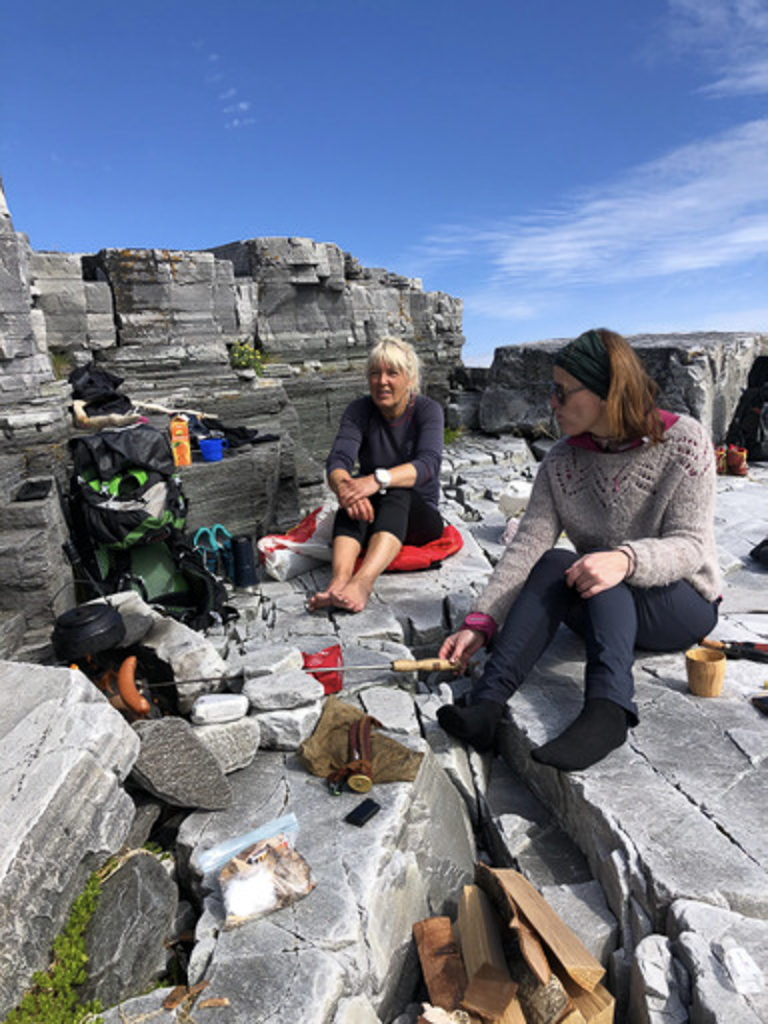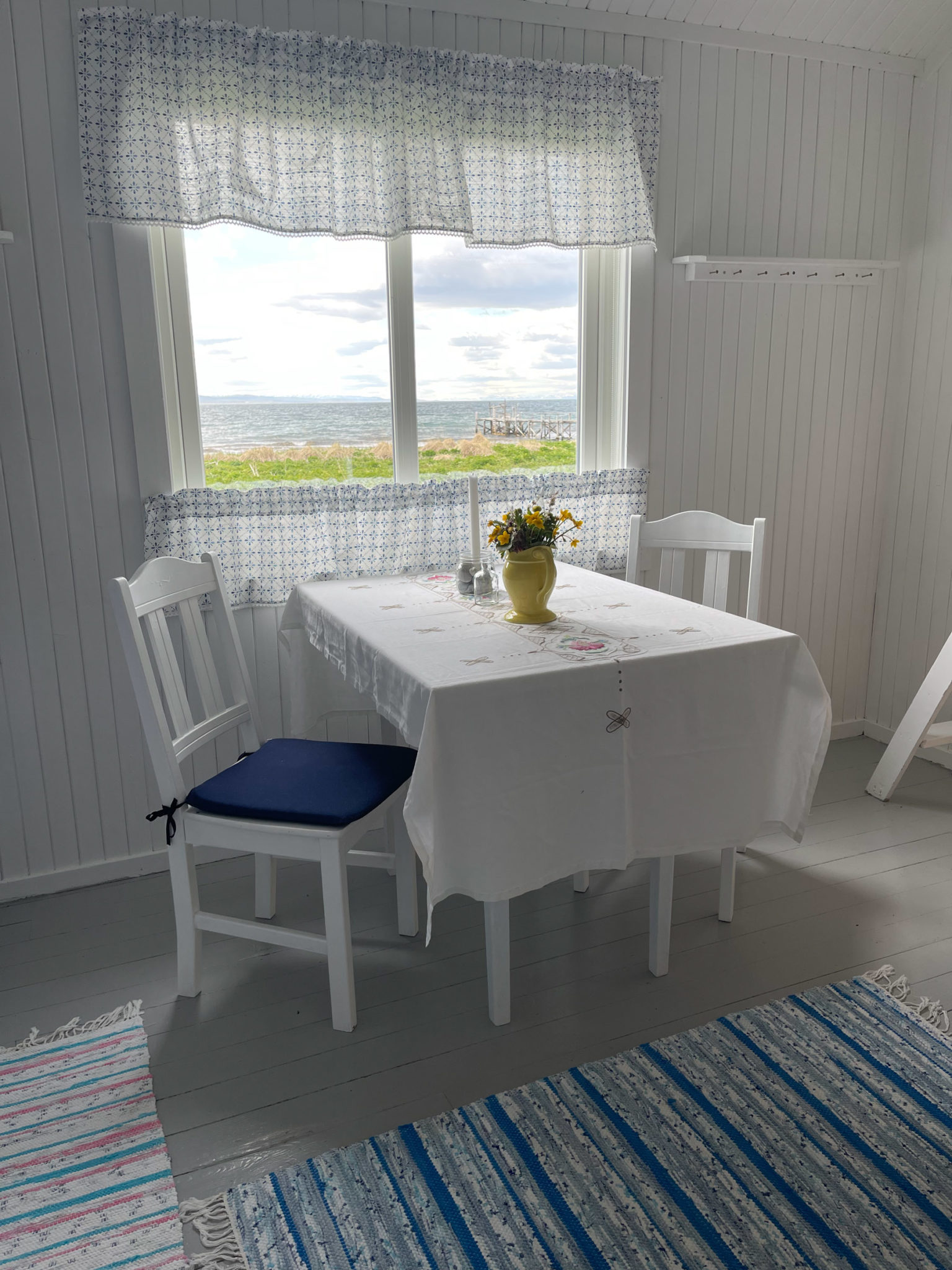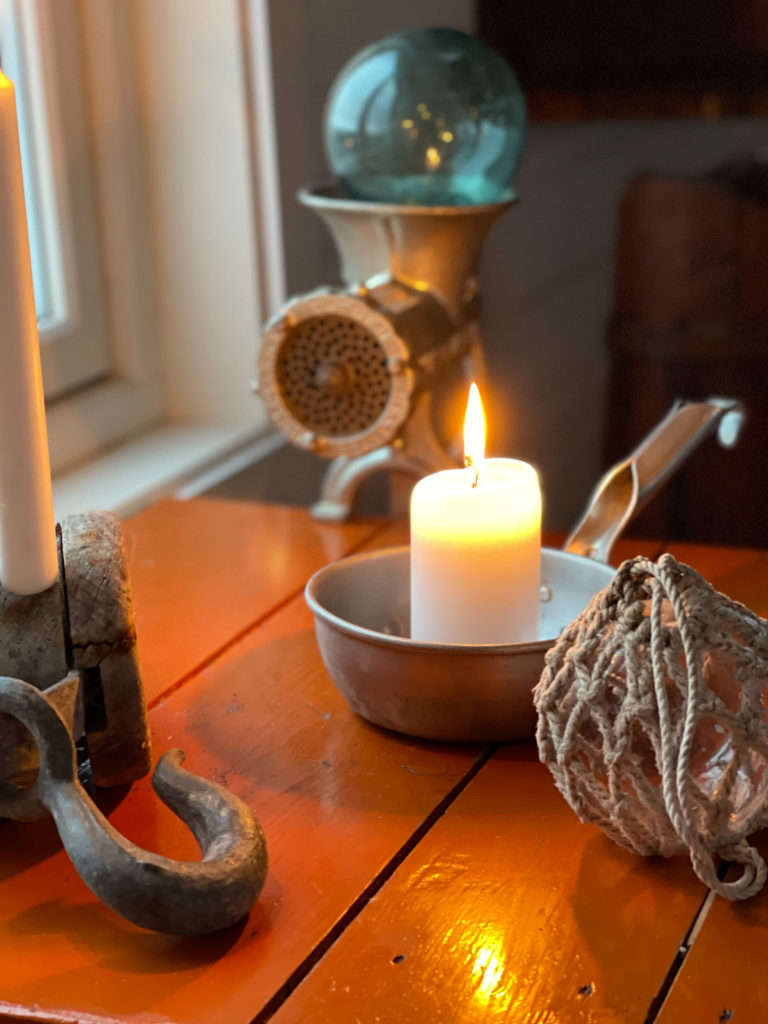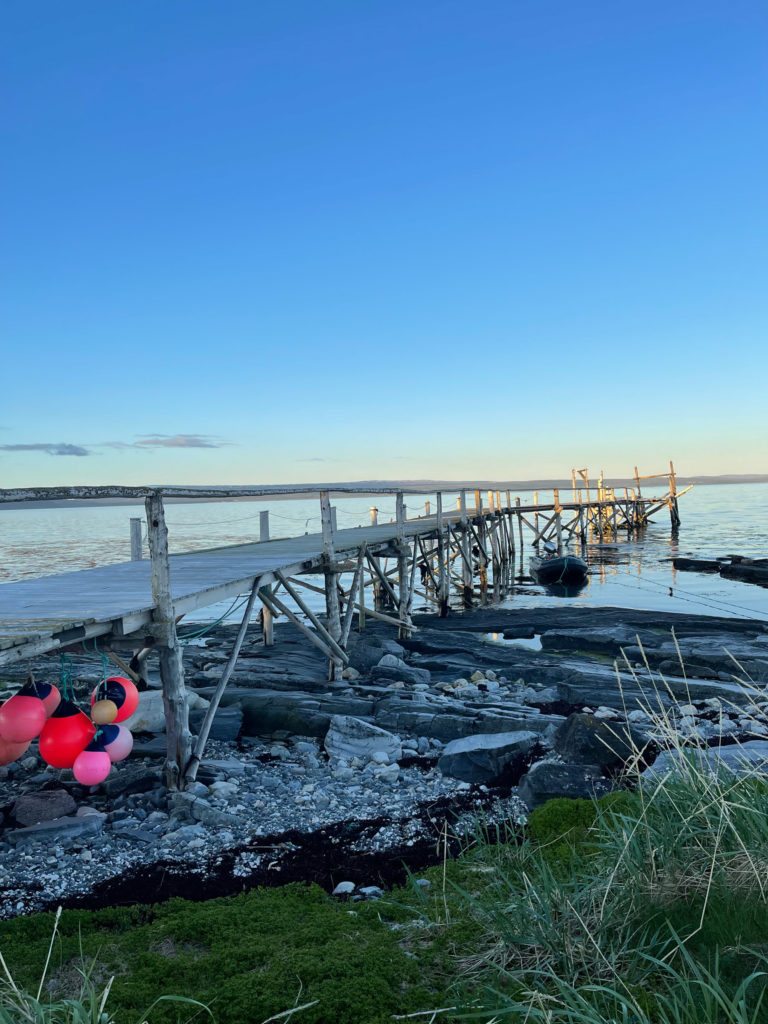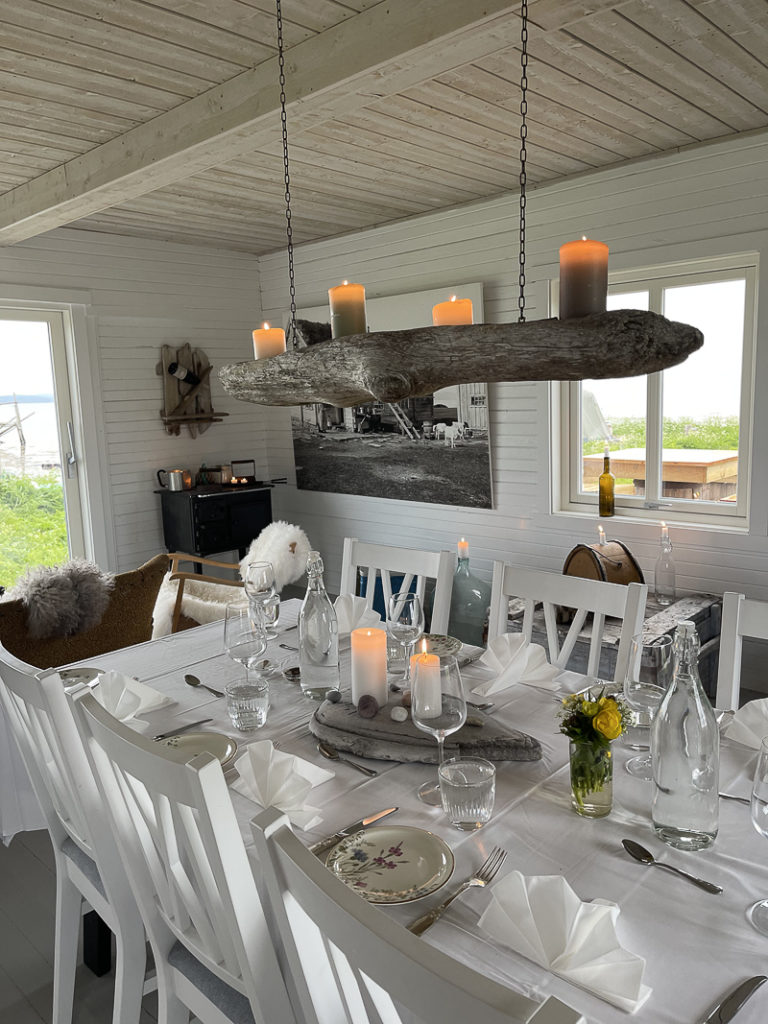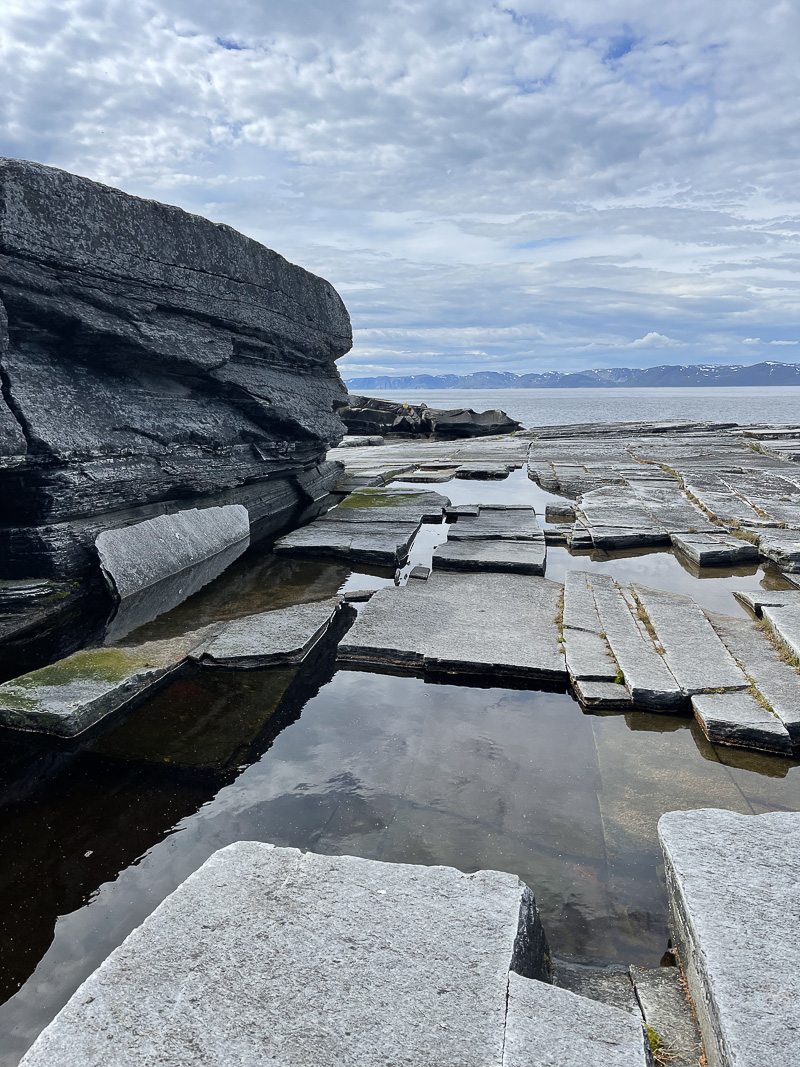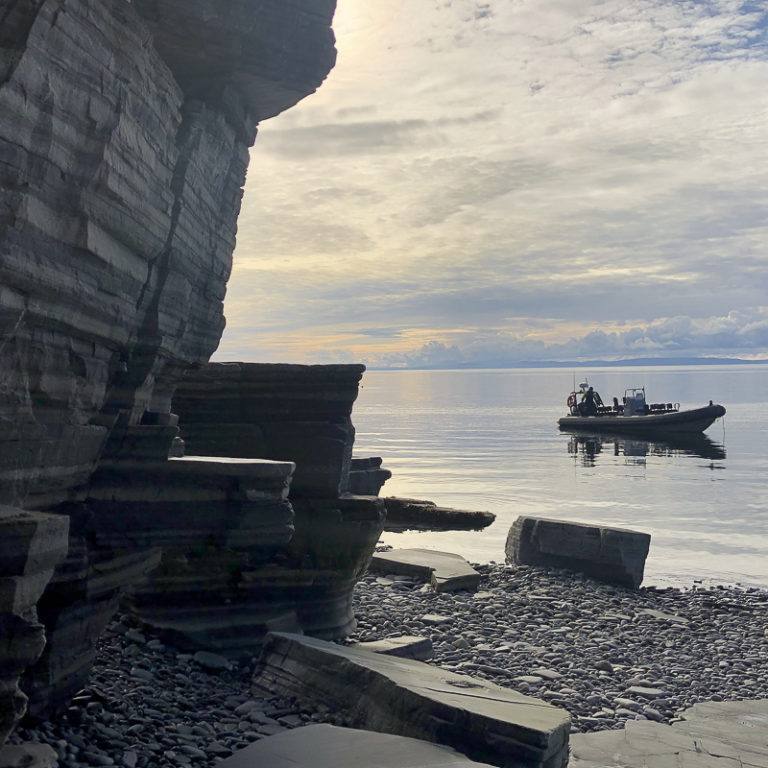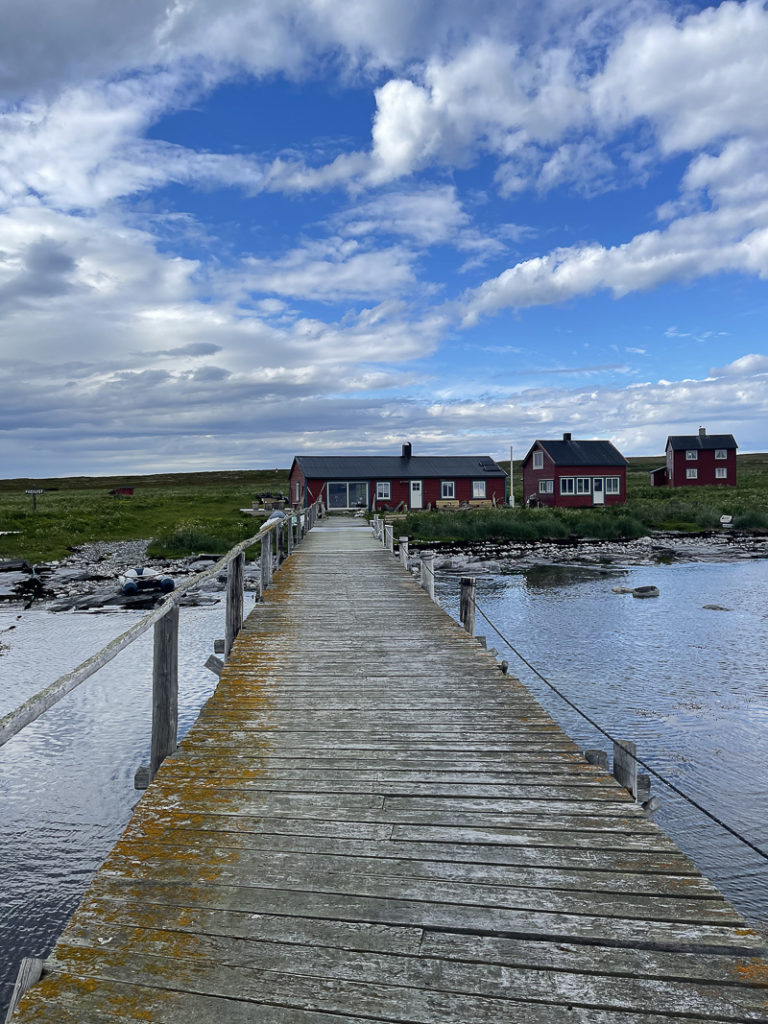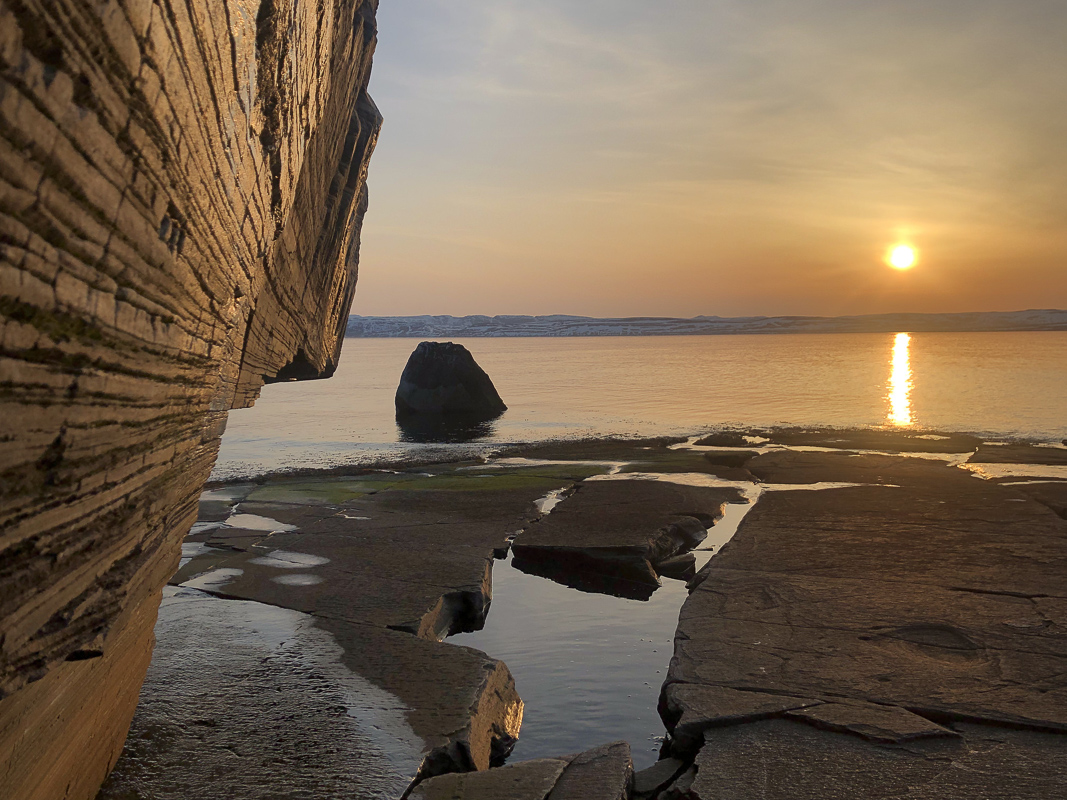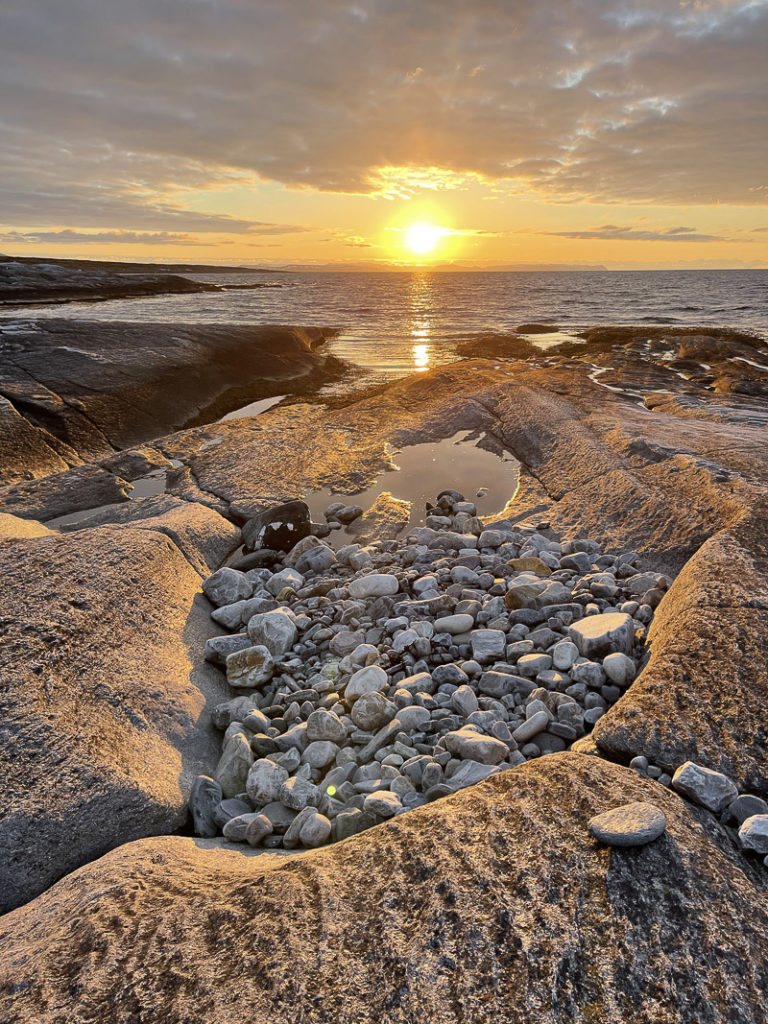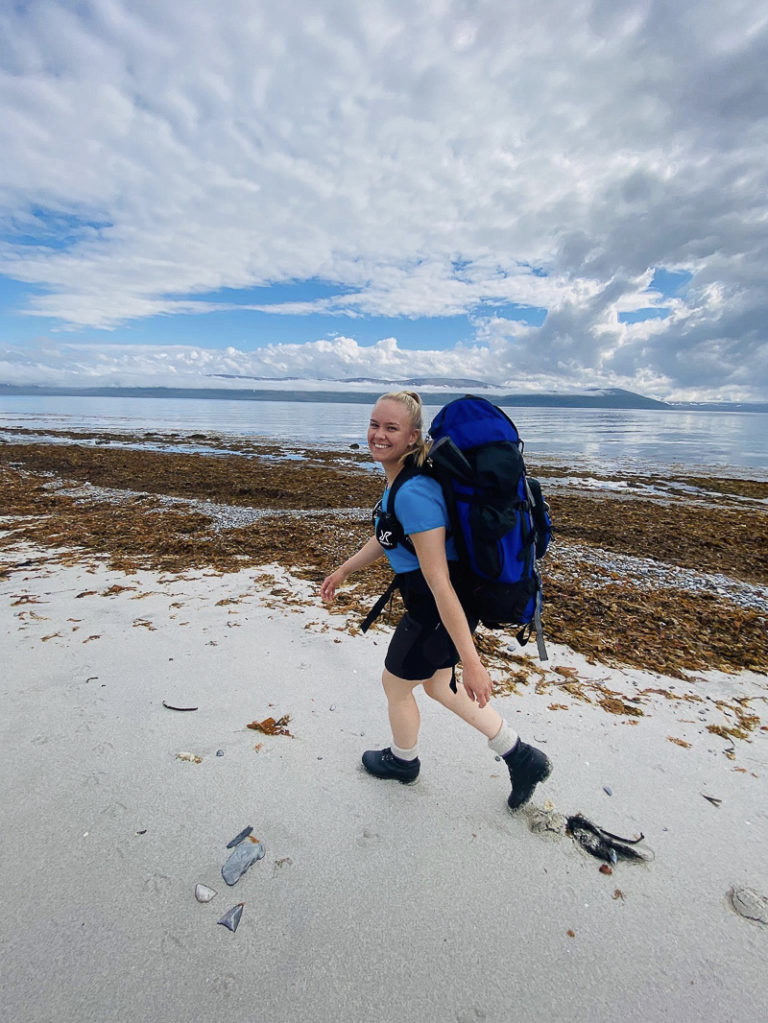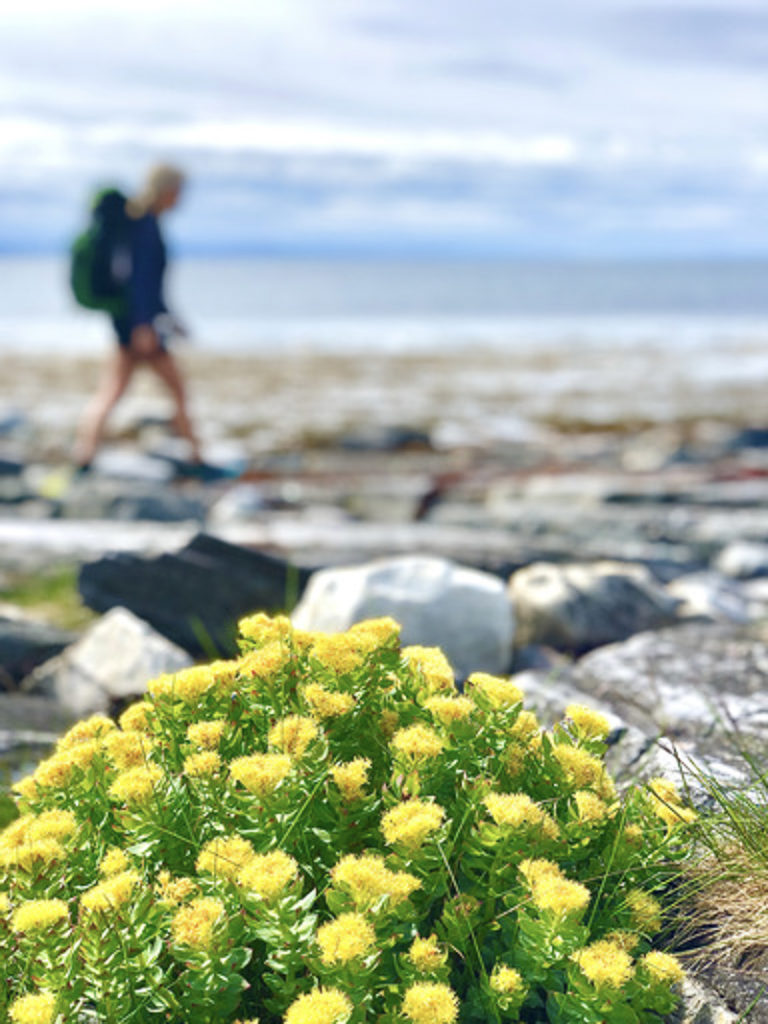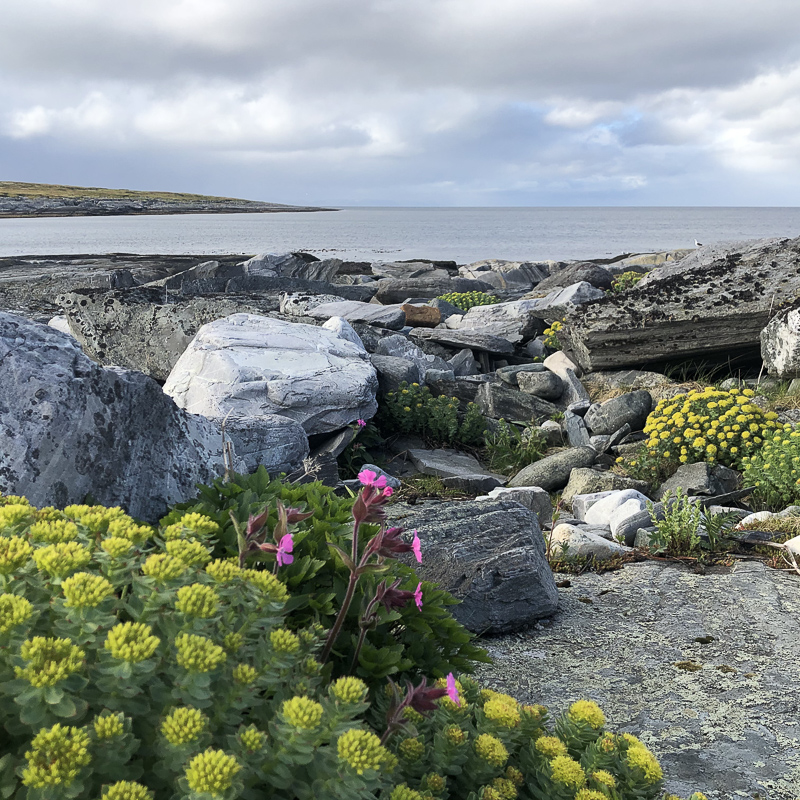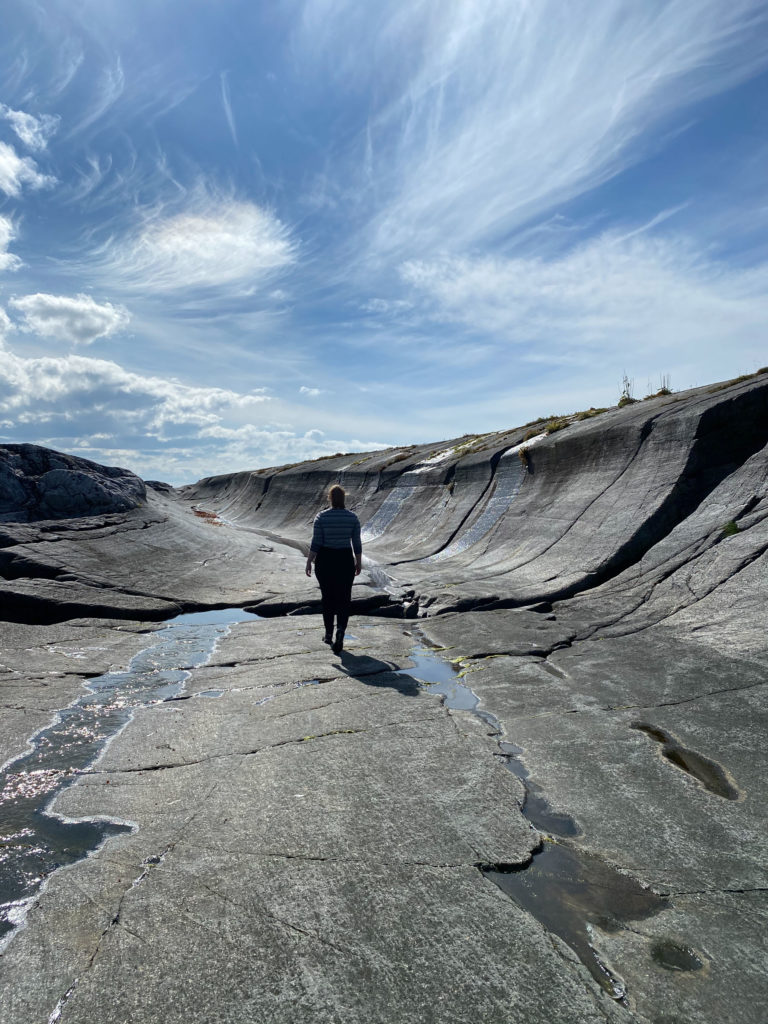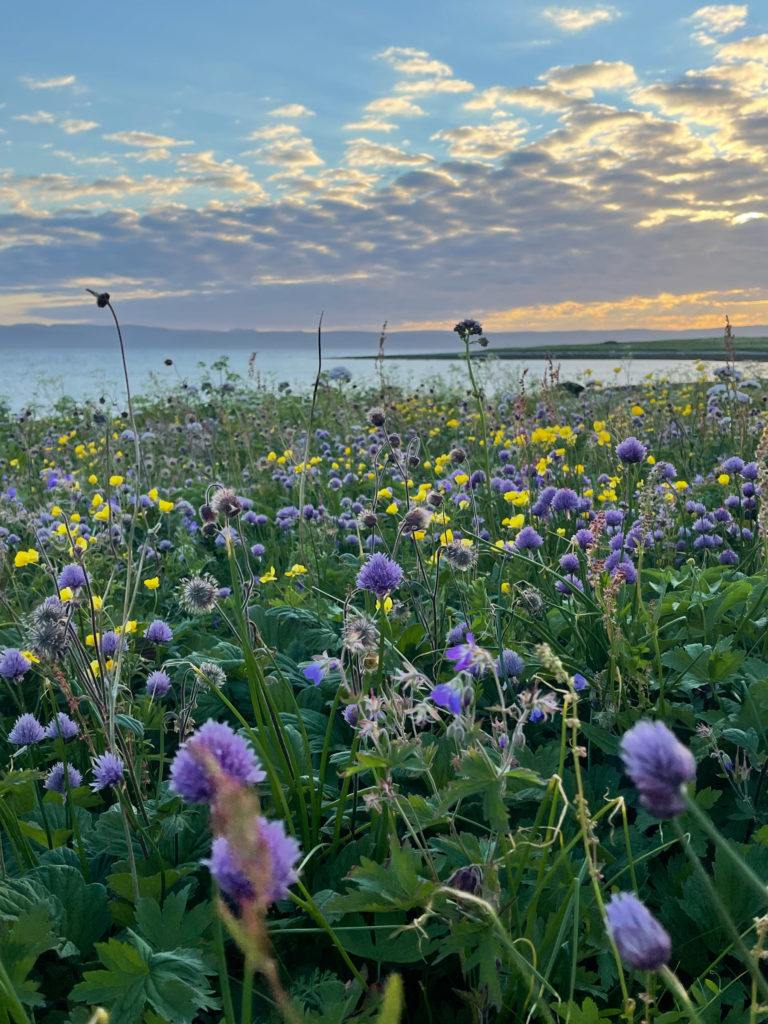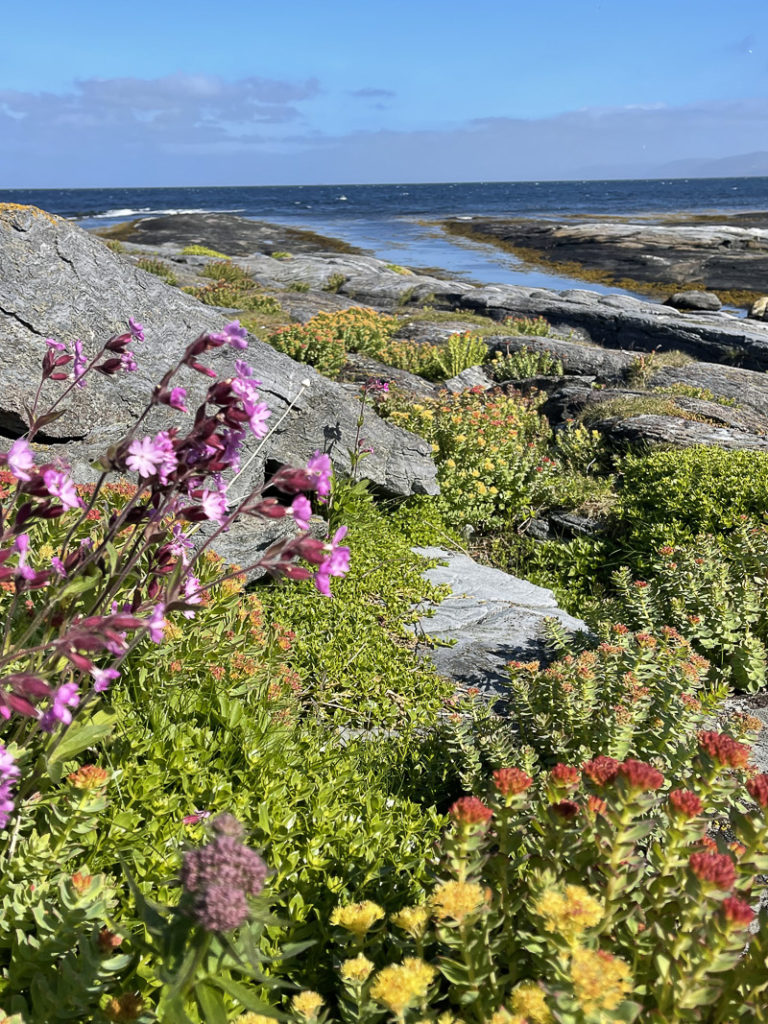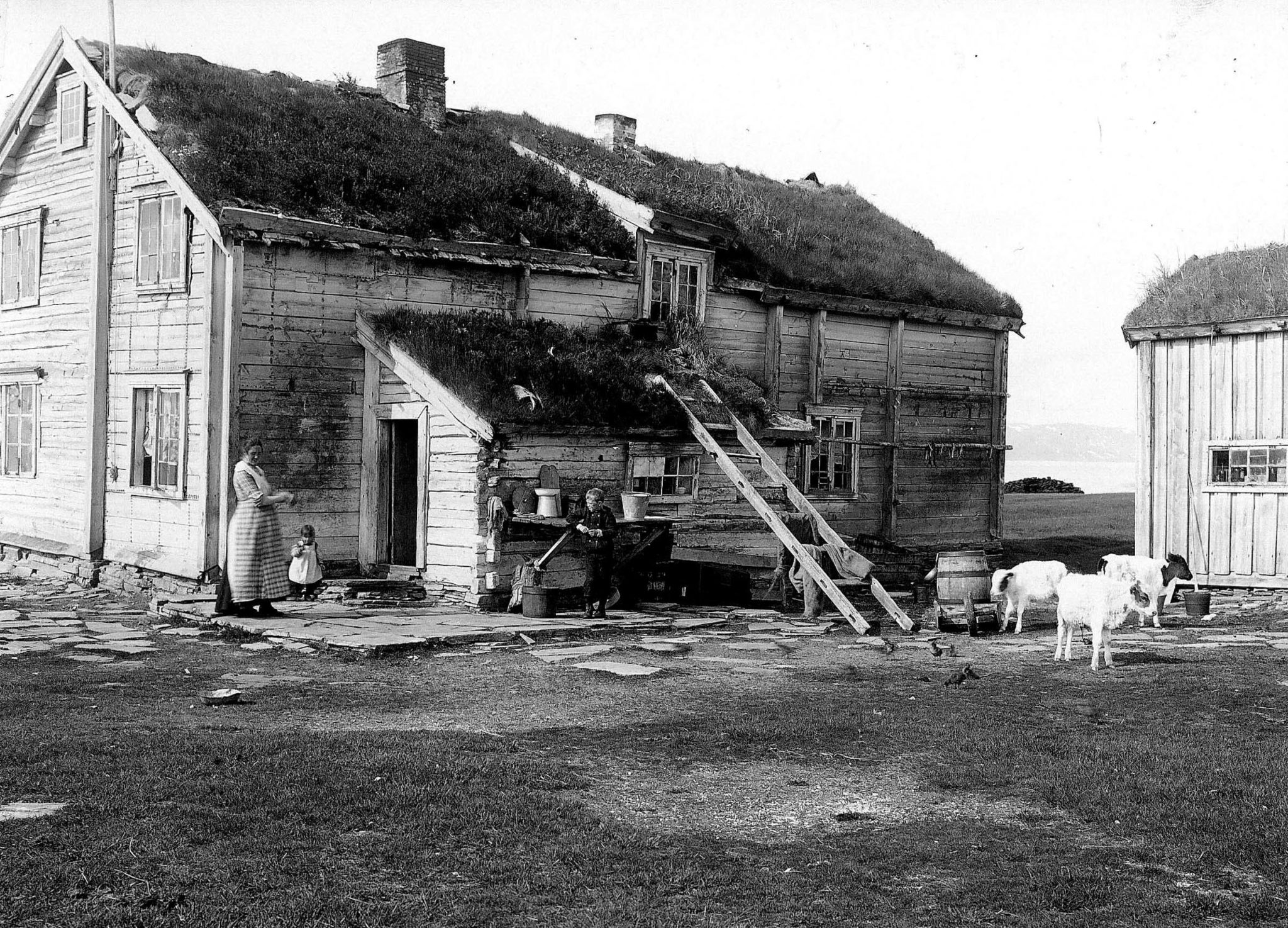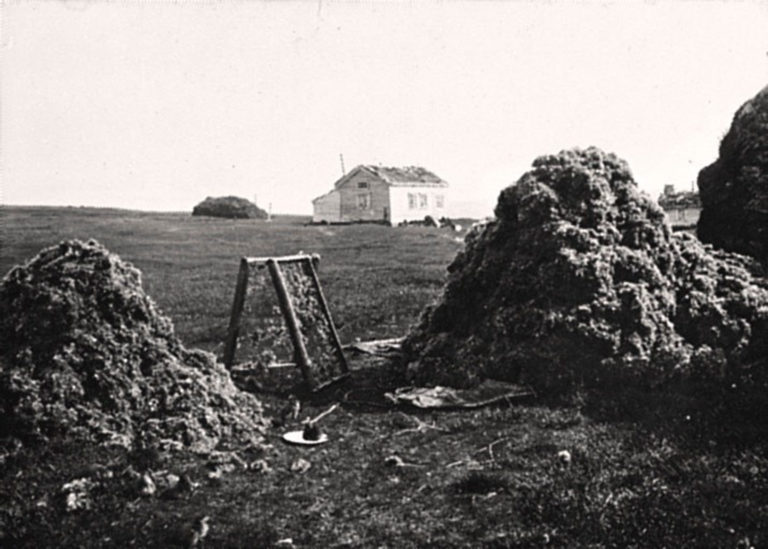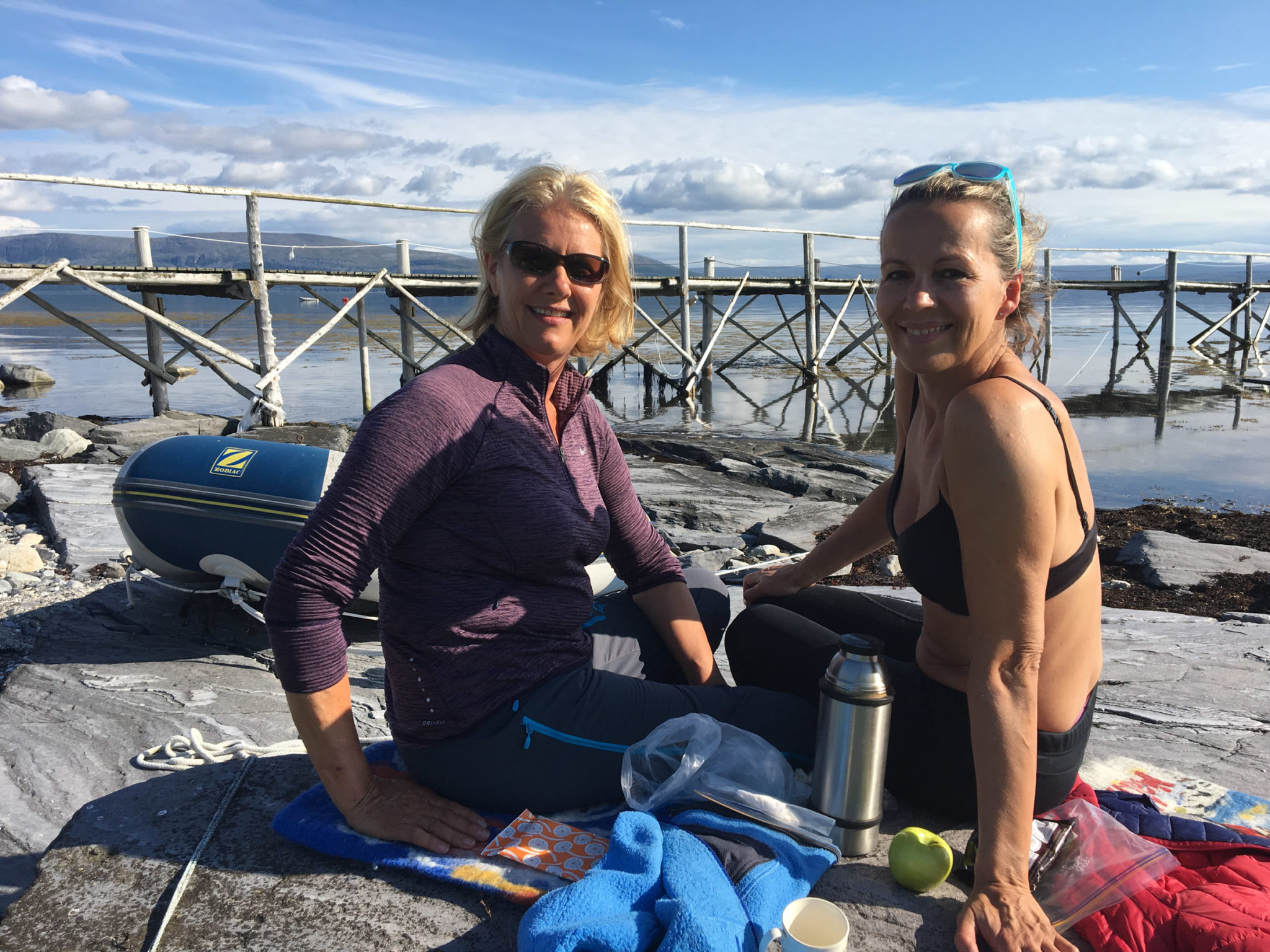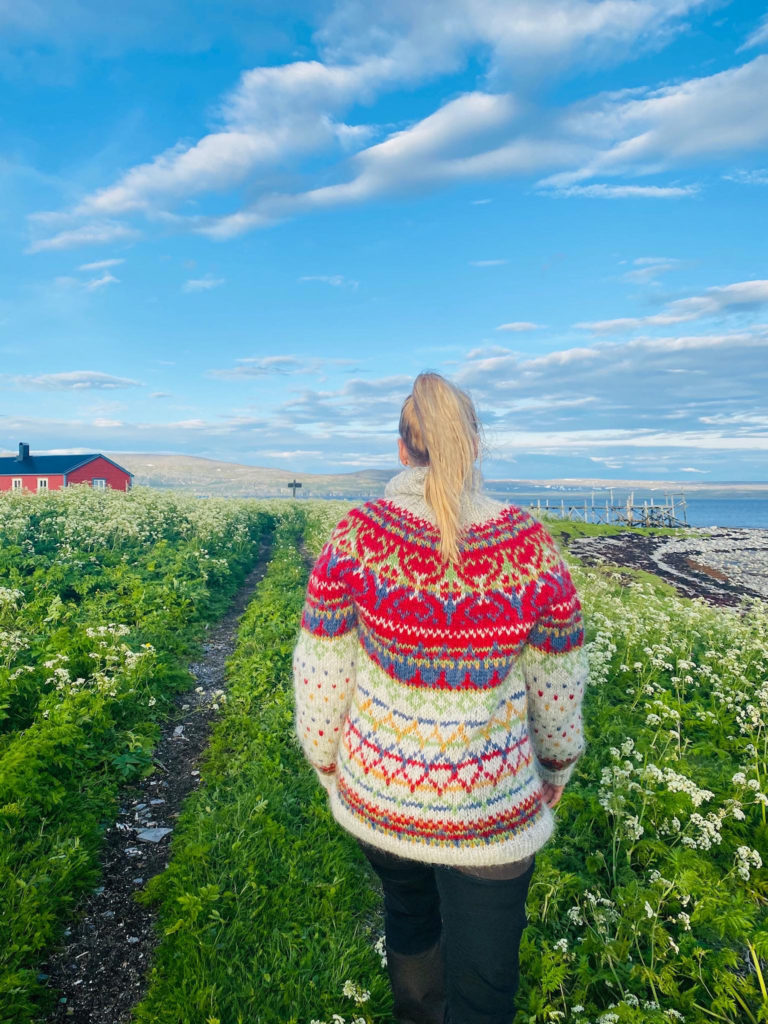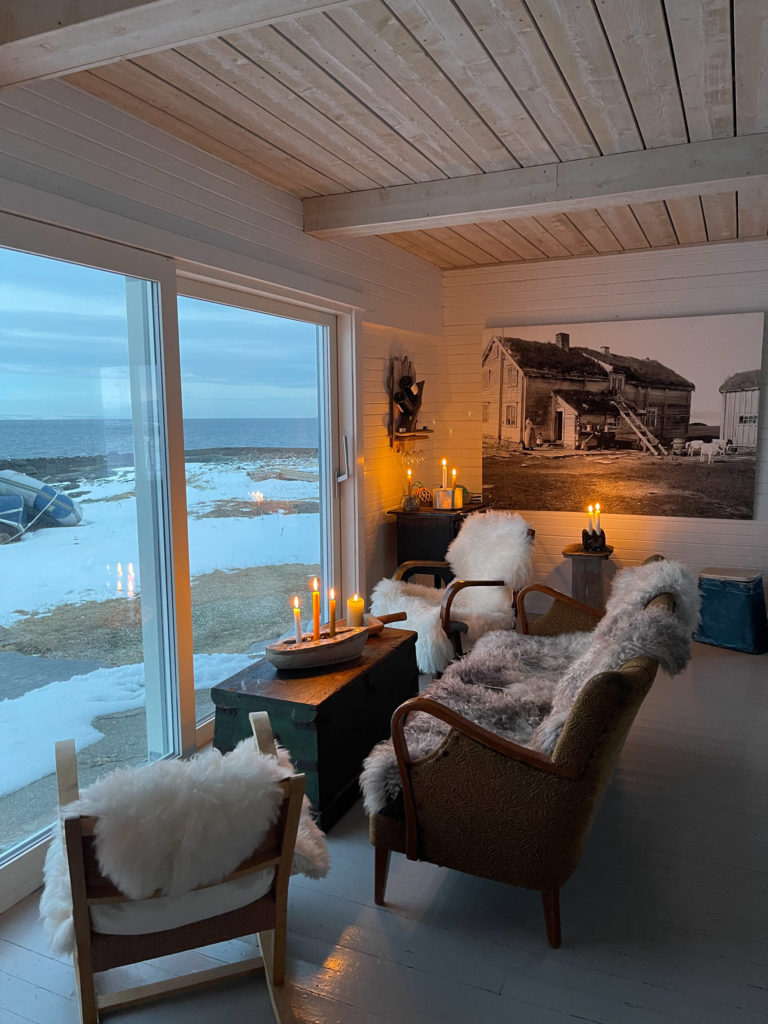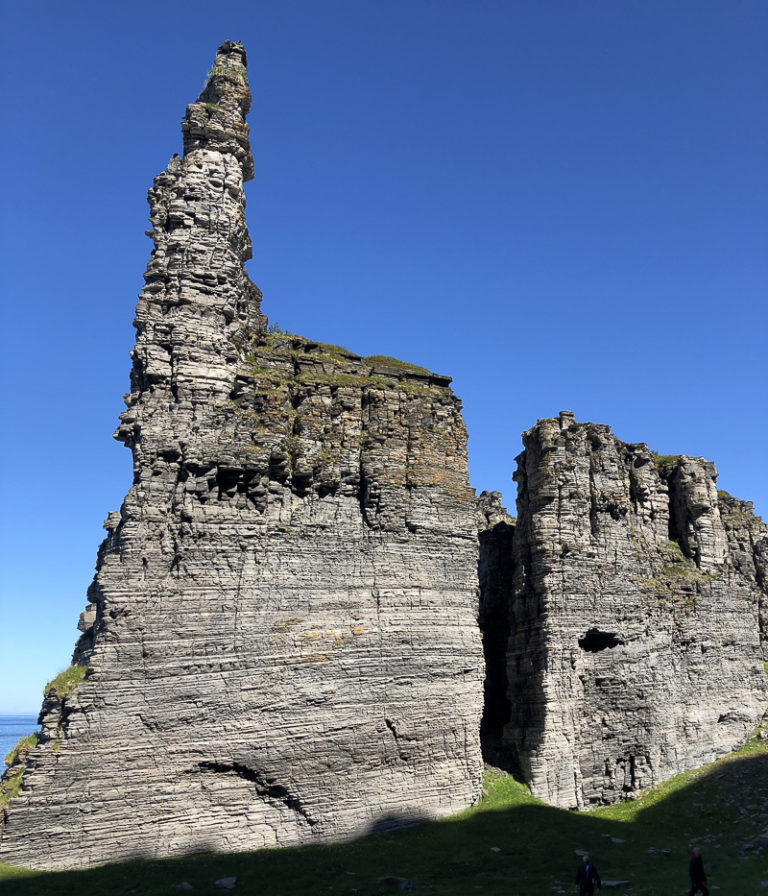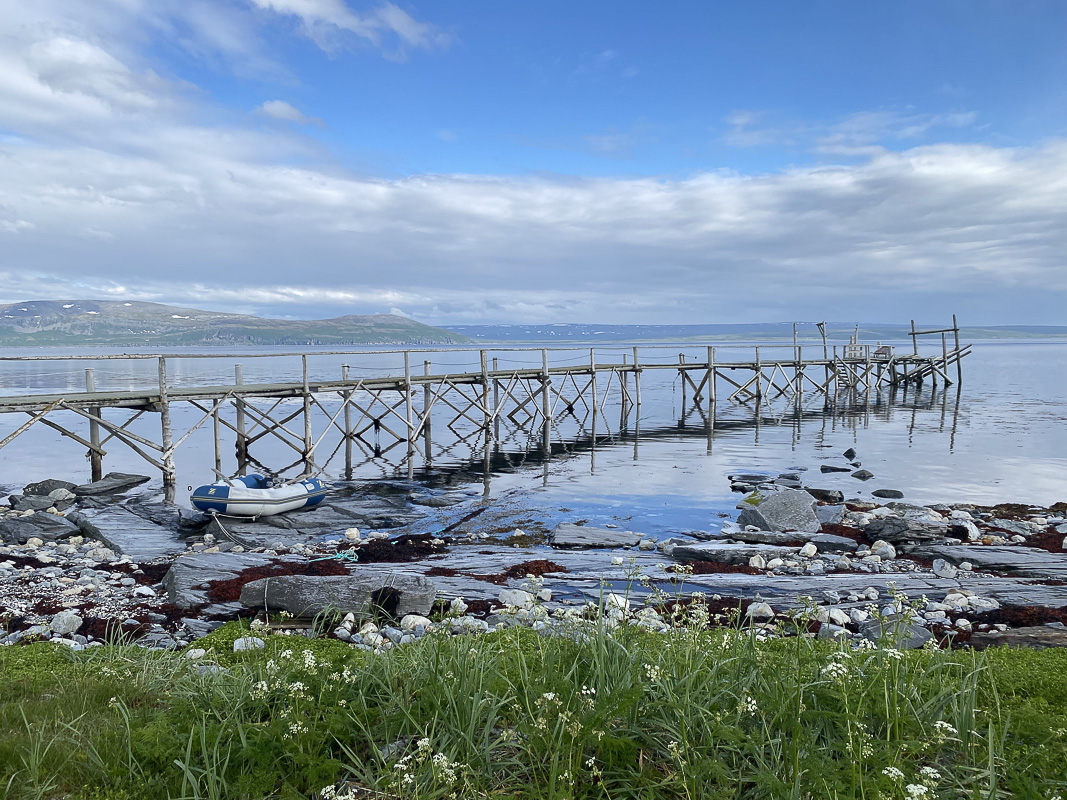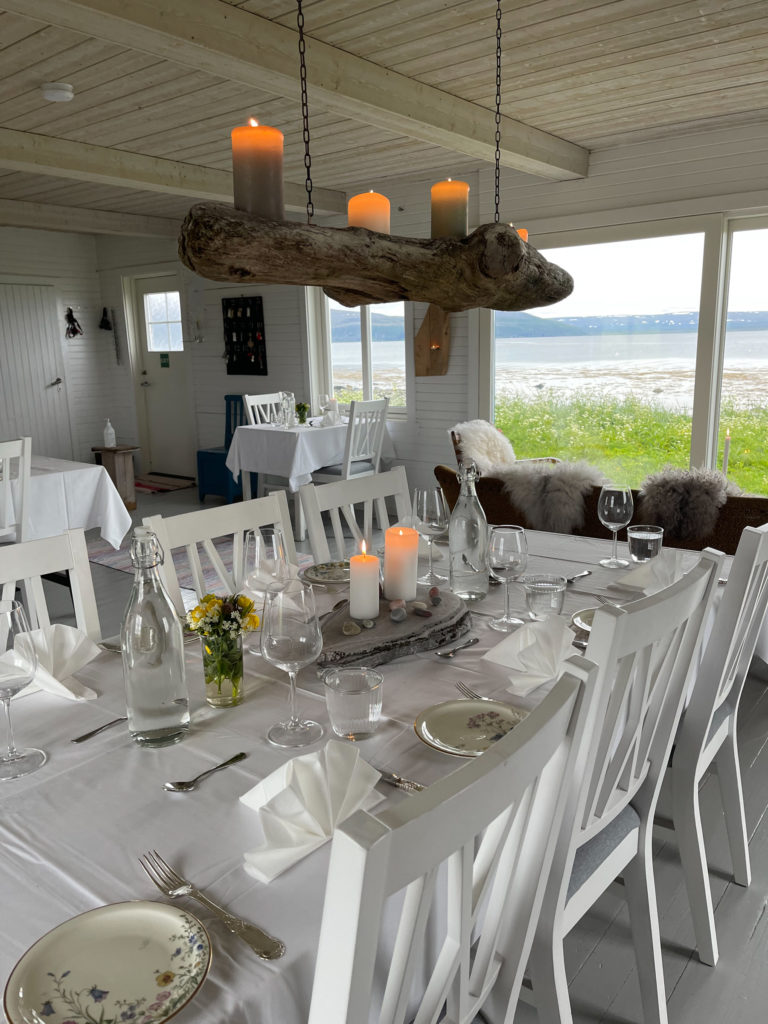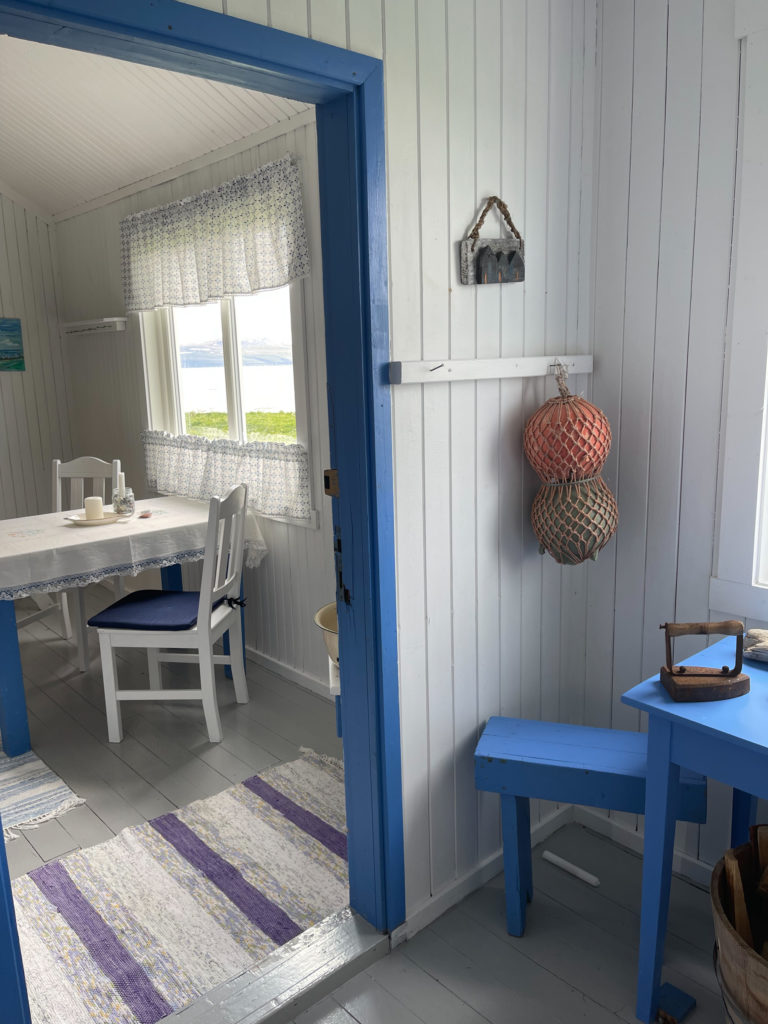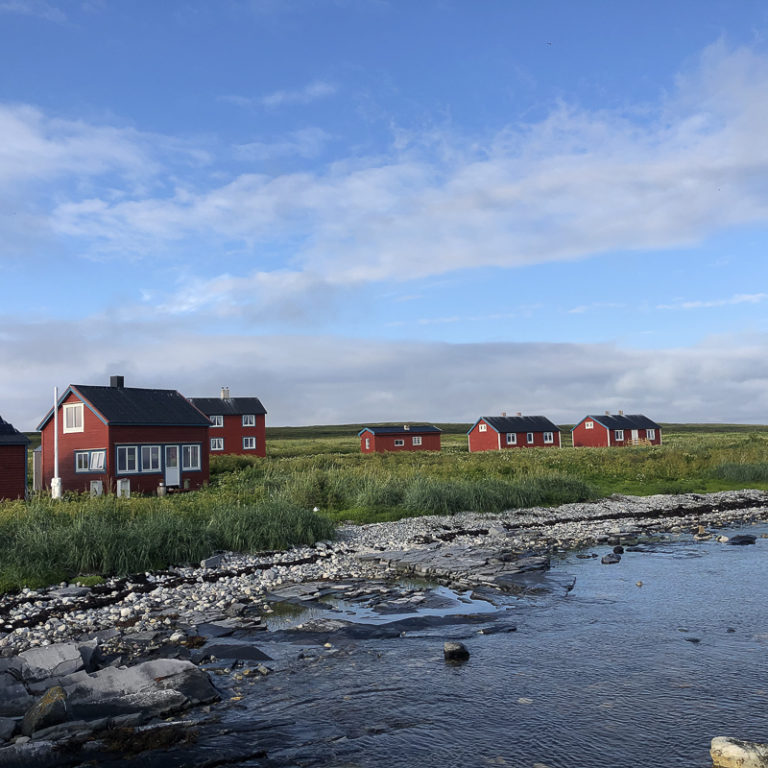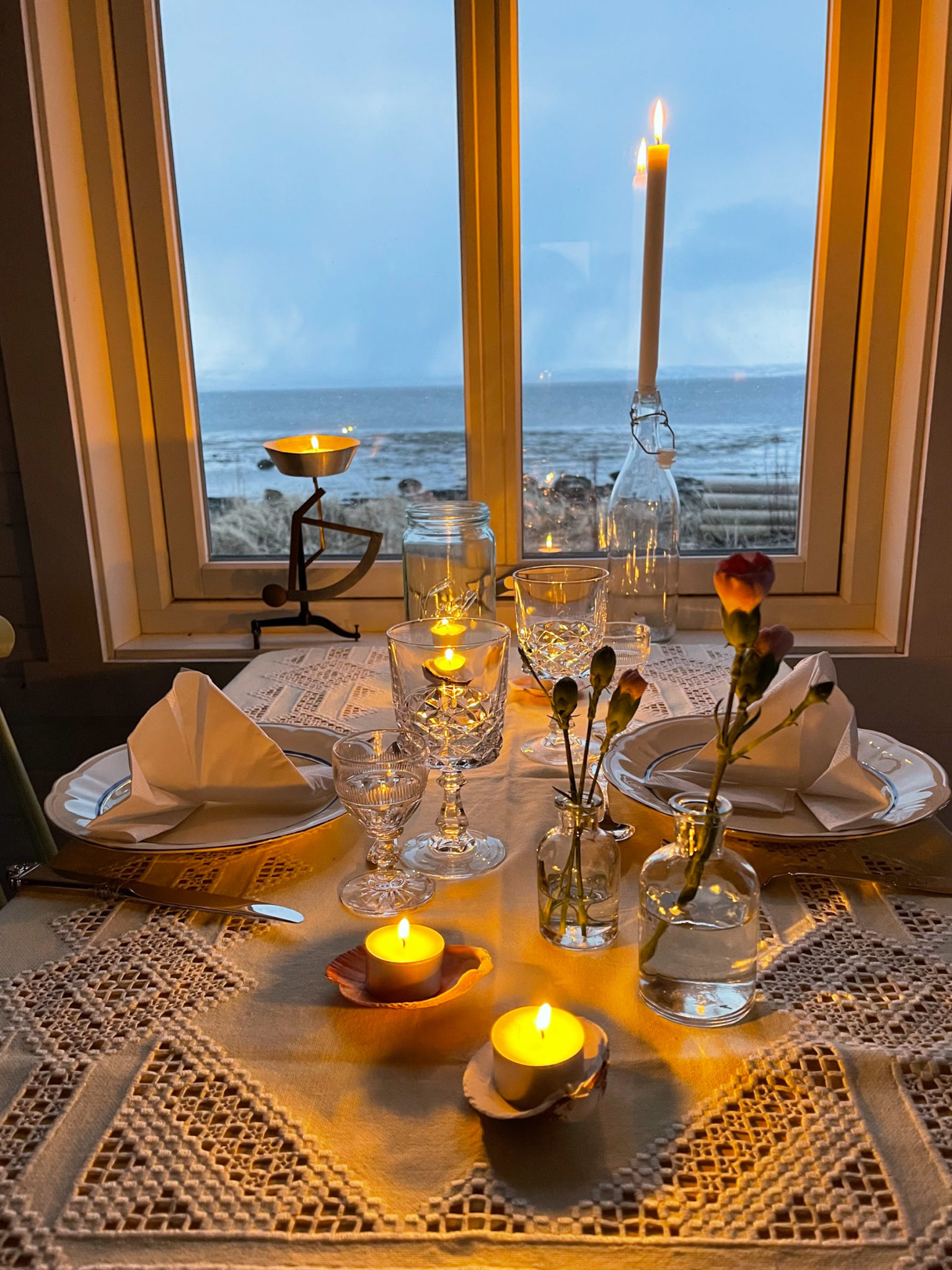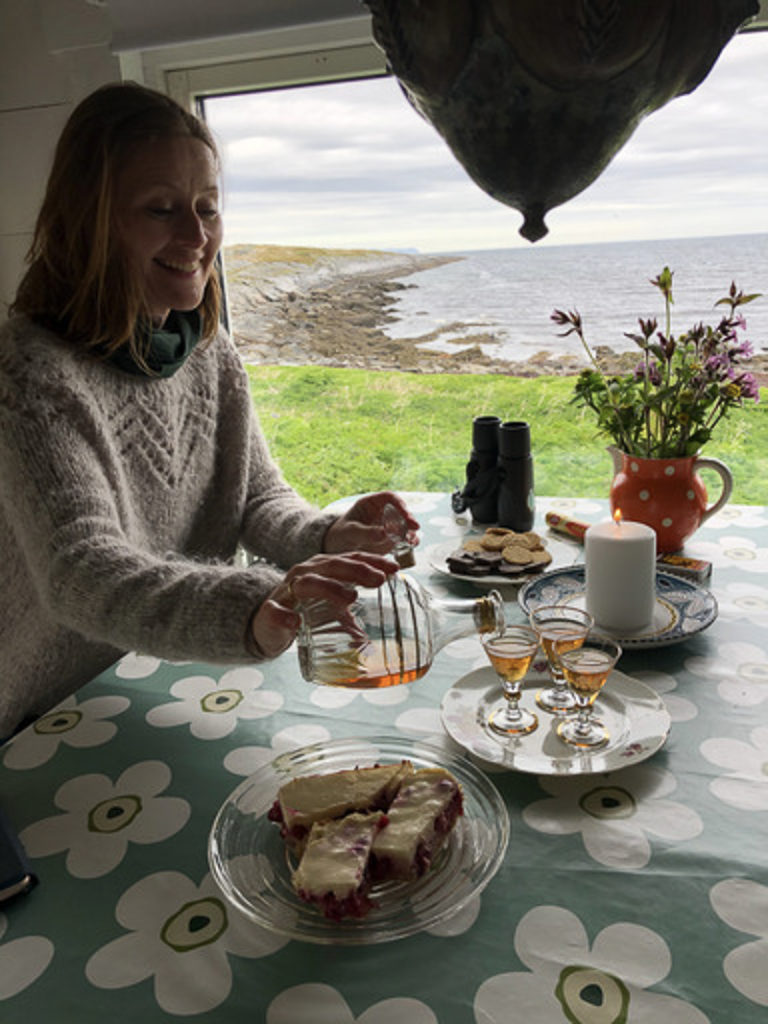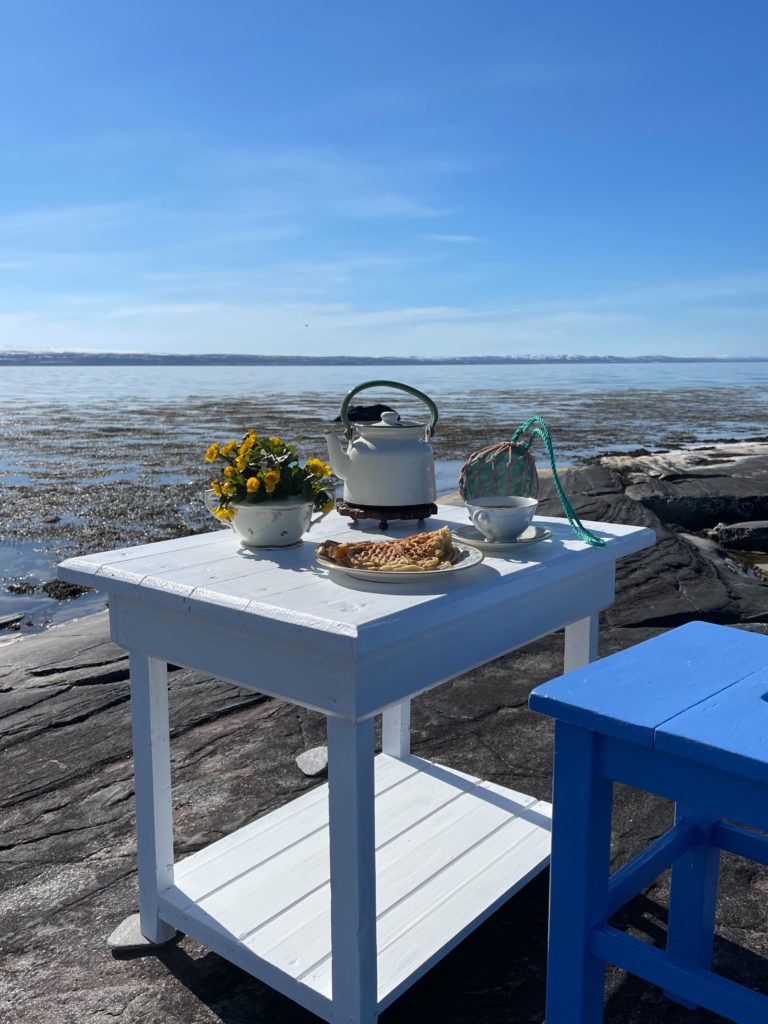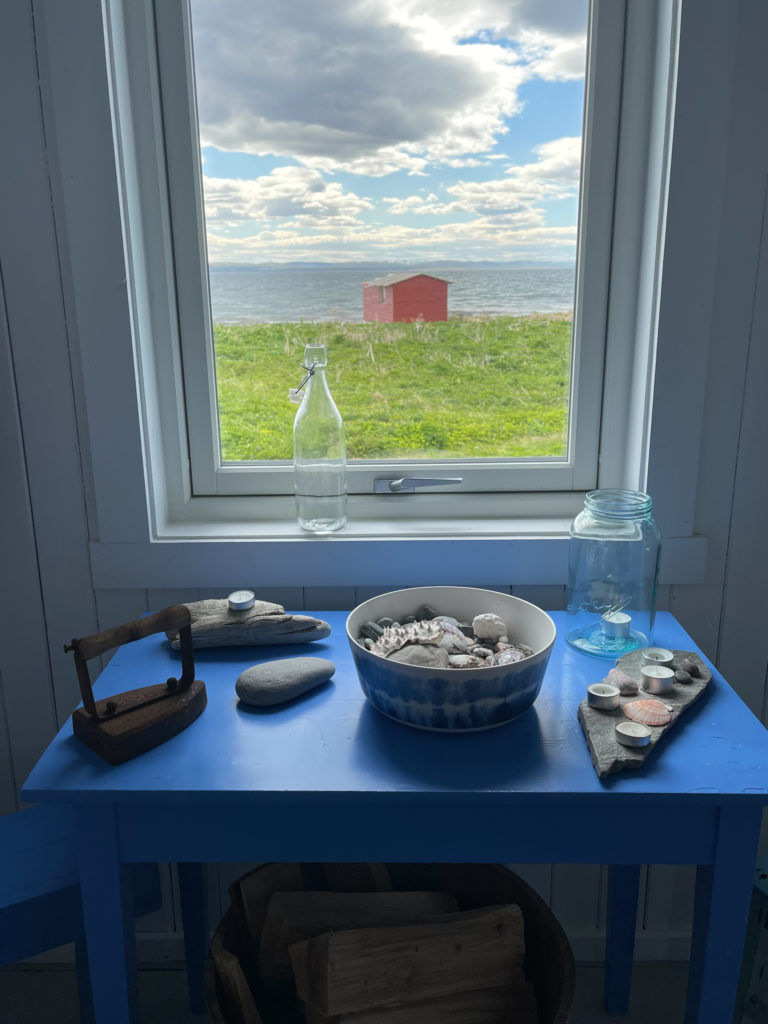There is a Garden of Eden not too far from the North Cape, an island of abundance in the middle of barren Arctic lands. Come to Tamsøya for peace and solitude, for ever changing skies and a characteristic cultural landscape, for a rich history and many stories and above all to eat cloudberries.
Near the mouth of the big, wide Porsangerfjord, and with strong historic ties to the North Cape island of Magerøya, Tamsøya is a small island, some 13 square kilometres in size. It’s also very low, the highest point is 65 metres. A good microclimate, ample fertilizing by birds and the geology itself make the island lush and green in a barren, Arctic landscape. The good conditions are noticeable both in quantity and quality.
Anne informs us on Tamsøya’s past and present
Anne Sivertsen is our contact on the island. With her husband Olaf, third generation of the Bull family, she runs the small berry picking and tourism company on the island. Their job is a labour of love, where respect for the old ways takes precedence over convenience and the fast buck. A visit here is thus a meeting with traditional life in the furthest north.
The cloudberries dominate the island
Depending on the weather, the cloudberries blossom in mid to late June. Tamsøya’s wide, flat expanses are then covered by the fragile, white flowers. Sometimes in July, the berries appear in a shining red colour, picturesque but far from ripe. In the first two weeks of August, they change colour from bright red to a luminous, vibrant orange, and are ready to be harvested. Time to get working!
The busy picking season was an important source of income in the north
Traditionally, people came from the shores of the Porsangerfjord and from the North Cape Island of Magerøya in August to pick cloudberries. They stayed in simple shacks, got up early and worked 12 hours a day picking berries. The result could be up to 70 kilos a day, and the berries had to be carried to the bærsjå (berry shack) in two turns. A share of the harvest was given to the owners as a rent, and the rest could be sold, giving extra income to people that needed it desperately.
Today’s berry season is as hectic as ever
These days, the economy in cloudberry picking matters much less. But berry picking has long traditions in the far north and securing a good winter supply of this tasty berry, so full of vitamin c, is important to many. Local pickers are often in their sixties and seventies, a few into their 80ies. . These days, however, with the increased focus on healthy, natural food and traditional diets, city dwellers from Tromsø and Oslo make it to Tamsøya. Some of them have roots in the area, others have just heard about the legendary Tamsøya cloudberries. The first two weeks of August are backbreakingly busy, and one should only go here then if one means cloudberry business.
Come before the berry season for relaxation
If your idea of fun is not to spend many hours a day picking berries, avoid the busy first half of August, this period is set aside for the berry pickers. Sometimes in June, the people in Tamsøya open the summer season and welcome guests. Then you come here to witness the cloudberry blossom, to see how nature explodes in colour and greenery. July is the hight of summer, with the best temperatures. Mosquitoes, a pest elsewhere in the north, are chased away by the constant draft. The midnight sun shines almost to the end of July.
Dark evenings and autumn colours herald the end of the Tamsøya season
After the end of the berry season in mid-August, nature is already getting ready for winter. Autumn colours start appearing in late August and are at their most intense in early September. You can pick blueberries, which are also in abundance, and the cloudberries that ripened the last. From mid-August, dusk sets in around Midnight, and by early September there is real darkness for hours. That’s when candles and kerosene lamps are lit, and the atmosphere turns into Scandinavian kos. Before the first snowflakes dance in the air, doors are closed and Tamsøya is left to the wintering ptarmigans.
The houses are a nod back to 1950
I asked Anne provocatively “wouldn’t it be simpler just to tear down the old houses and build some modern bungalows?”. She laughed aloud “the though never crossed our mind”. Around 2017 they decided to restore the old houses to their former glory. A glory characterised by the simplicity and straight lines of the reconstruction era. Roofs were repaired, everything got a lick of paint, old things were found in the upper shelves of the kitchen and in the attic and given a shine. A few visits to the antique shop in Lakselv added to the impression. The hand-woven mats add warmth and colours to painted wooden floors. The houses haven’t looked better since they were built around 1950. Mature Norwegians are thus taken back to childhood countryside memories.
The toilet doorway frames the view
One of the consequences of keeping everything as it was, are the outhouse toilets. The privies are as dry as they were in 1950 but are kept spotlessly clean. While you carry out your business, you of course keep the door open to enjoy the landscape. As there is nobody around, your privacy is secured.
You eat well at Tamsøya
Cod from the North Cape area, a solid beef burger from local oxen, reindeer provided by the Karasjok Sami that keep their reindeer in the area; there is a lot of good food served in the homely dining room. The condiments are from Tamsøya; rhubarb jam, rhubarb chutney and angelica chutney. Guess what’s for dessert! A tipple of cloudberry liqueur rounds off the evening.
Hike to the berry picker huts
A safe and easy way of exploring Tamsøya Island is to hike the perimeter of the island. Just by following the shoreline. The overnight stay is in a plukkerhytte – berry picker cabin – which is very simple accommodation. But in an Arctic summer, you need nothing more. The terrain is easy, mostly polished rock, and there are no hills.
Get close to nature
One of the most striking features of the hike is the flora. The island’s premier wildflower, in addition to the cloudberry, is the golden root (Rhodiola rosea) which is found in vast amounts around the shore. The earliest guests can witness the Finnmark primrose (Primula nutans ssp finmarchica) blossom, rare and protected. Rare and beautiful is also the pale red large pink (Dianthus superbus). The birdlife is as impressive, with all the seagull varieties in Norway, geese, eider ducks, common curlews, oystercatchers, terns and divers or loons. Even the geology is varied, with rounded, sleek rocks on the eastern coast, and sharp slate layers on the western side.
How do you keep your footprint small?
When hiking around the island, you should try not to wander too much into the grass and heather. Stay in the shore area. This is because the birds hide their nests in the vegetation. As you turn up, our feathered friends set off the alarm. Oystercatchers run frantically around to mislead you, and protective tern mothers fly hair-raisingly close to your head. If you stay on beaches and rocks close to the water, things calm down quickly.
How did an island become private property?
To begin with, Tamsøya was a small coastal community used by the locals, Sami, and Norwegians alike. Initially owned communally, land was during the 19th century seen as State property. In the 19th century it was leased to the vicar of Kjelvik – Honningsvåg’s predecessor. This was a very profitable affair, and the island delivered cloudberries, eider down and seagull eggs at a great profit. The vicar was then able to buy it. His descendants didn’t, however, run it so well, so in 1927 the Bull family bought it on a forced auction. Today, the third generation runs the island. Anne Sivertsen, our source for this article, is married to grandchild Olaf.
Cloudberries, eider down and seagull eggs made Tamsøya valuable
In the 19th and early 20th centuries, Tamsøya had a few year-round residents, living as tenants or crofters for the Bull family. They gathered seagull eggs in spring for sale, they of course picked cloudberries and they also tended eider ducks and picked the down to make feathers.
Marie is a source to old Tamsøya life
Anne Sivertsen went to the care home in Lakselv in 2019 for a chat with Marie Nilsen, the last to be born on Tamsøy in 1934. Anne made valuable notes after the talk. Marie said that 300 German soldiers stayed on the island to man a radar station. The locals got along well with them, and they could get candy and sweet bread. The rhubarb guests enjoy today was planted by Marie’s mother. Eggs from the eider ducks were used to make pancakes. Peat was used for heating, as there is no forest on the island.
Tamsøya was abandoned
On the 11th of November 1944, the few residents were forcibly evacuated, and all the houses burned. After the war, there was no year-round population anymore, but the summers were still busy. The last down duvet was sown in 1962. The seagull population across the north is today under threat, and the Tamsøya people feel no urge to gather eggs anymore. Cloudberries, though, are as important as ever. It may not be a source of wealth anymore, but it certainly represents a fair bit of historical and cultural capital.
Tamsøya’s reputation reaches far
On the 10th of August 2015, two helicopters landed on the island. Out stepped the entire Norwegian royal family. No wonder they wanted to inspect the island, after all Tamsøya delivers to the royal court. If you find the story hard to believe, their signatures can be inspected in the guest book. The Tamsøya cloudberries were already legendary in the north, now their reputation is firmly established in the highest circles.
How do you get to Tamsøya?
Tamsøya is not for everybody. No electricity, no flushing toilets, and no evening entertainment, this is a place for those seeking solitude, nature and contact with the Finnmark past. The season opens sometime in June, and lasts to early September. One cannot turn up on a small island without notification. Make sure to contact the hosts of Tamsøya, arrange for accommodation, transport by RiB boat and meals. Then it’s up to you to decide if this is a once in a lifetime thing, or an addictive habit.
Facts about Tamsøya
Tamsøya Island is a 13 square kilometre island in the Porsangerfjord. It belongs to the municipality of Porsanger, but is most accessible from the settlement of Repvåg in Nordkapp Municipality.
As a private island with no public transportation, all visits are decided with the local hosts.
The hosts operate an excellent website. For quick updates and inspiration, the facebook page is great.
Visit North Cape has everything about the area on their well-stocked website.
